How to Tow a Dinghy Behind a Sailboat
Avoiding Common Problems Which Can Become Emergencies
Tom Lochhaas/ThoughtCo.
- Snowboarding
- Scuba Diving & Snorkeling
How best to tow a dinghy behind a sailboat is a classic dilemma around which sailors have built many different opinions. The best method often depends on the type and size of the dinghy, the type and size of the sailboat, and wind and sea conditions. Usually, there is no one best answer. The best advice is to consider all your options at the time and remain flexible to make changes once underway.

The Essentials of Towing a Dinghy
- With a hard dinghy, which usually tracks well in calm water, attach the painter (tow line) at the bow, preferably 6 inches or more below the stem to ensure the bow rides high.
- With an inflatable, use a towing bridle that connects to two points on either side of the bow, to help ensure the dinghy is pulled straight.
- Use a floating line for the painter to ensure the line does not droop underwater and foul the towing boat's prop or rudder. (This crucial issue is often overlooked and has led to many emergency situations.)
- Unless you are absolutely sure the water will remain flat for the duration, move the dinghy outboard engine to a rail mount. (Dinghies are frequently overturned by waves, and outboards lost or ruined by immersion.)
When Conditions Get Rough
Several problems can occur with a towed dinghy due to wind, waves, and currents. Here are common issues and some solutions:
Following waves cause the dinghy to surf forward, possibly striking the boat. This is happening in the photo above. The dinghy may also be spun around such that the outboard strikes the stern, causing damage. Possible solutions:
- Lengthen the painter so that the dinghy is towed further away, allowing it to recover from each wave and fall back before striking the boat.
- Pull an inflatable dinghy in very close to the stern and rig a line from each towing eye out to the stern quarters of the sailboat. When these lines are pulled tight, the dinghy snubs against the stern and cannot twist around. Some sailors always tow their inflatable this way, even with the bow lifted somewhat from the water.
- Note: neither of these solutions prevents the dingy from being blown or thrown by a wave sideways and possibly capsizing (unless the dinghy bow is snubbed tight and high out of the water).
A strong wind or waves from the side threatens to overturn or fill the dinghy. This can be a serious situation. Ironically, with a lightweight inflatable, removing the outboard makes the dinghy more susceptible to being flipped.
- If the risk for a lightweight inflatable flipping is due to the wind rather than waves, splashing some water into the dinghy with a bailing bucket (to add weight low) can help stabilize it.
- An inflatable can be brought alongside the boat on the lee side to be protected from both wind and waves. Move the painter attachment point well forward of the beam so that the dinghy nestles up against the side hull. This can be done also with a hard dinghy if it has a permanently installed fender system along its side.
The dinghy capsizes and fills or goes underwater. This creates an enormous drag that may do damage almost immediately. The tension may snap the painter or rip out the tow eye(s). At the least, the dinghy becomes a sea anchor slowing or stopping the sailboat.
- To recover the dinghy, slow the sailboat and bring the painter forward on the leeward side of the boat. Once the dinghy is beside the boat protected from wind and waves, it can usually be hoisted, cleared of water, and righted. You can usually manage an inflatable by hand, but with a hard dinghy, you may have to lower the mainsail, swing the boom over, and use a block to raise the dinghy with a winch.
Other Dinghy Options
The traditional method for traveling with a dinghy is to lash it upside-down on the foredeck. While this is generally the safest thing to do with a dinghy in all conditions, it can be inconvenient and difficult or even dangerous when shorthanded. Still, short of deflating an inflatable and stowing it away for an ocean passage, this is generally the best option when sailing in unprotected (or unpredictable) waters.
With a larger sailboat, if cost is no object, davits installed on the stern for raising and lowering the dinghy are a popular contemporary solution. While the dinghy thus exposed to wind and rain may seem at risk, fewer cruisers report any problems in settled weather up to gales.
- Learn How to Sail a Small Sailboat – 1. The Parts of the Boat
- How to Anchor a Sailboat
- How to Run in a Following Sea
- How to Tack a Sailboat
- How to Rig a Preventer Line
- Choosing an Inboard or Outboard Engine
- How to Gybe a Sailboat
- Tricing Pendants and Lifeboat Rigging
- Choosing a Centerboard or Fixed Keel Sailboat
- How to Heave To a Sailboat
- How to Raise the Mainsail
- Control Your Tiller Without a Tiller-Tamer
- The Types of Sailboat Rudders
- Review of Lehr Propane Outboard Engine
- Simple Reefing System for Sailors
- 6 Types of Boat Engines
Yachting Monthly
- Digital edition

Towing a boat: how to tow and be towed
- James Stevens
- August 22, 2021
When a boat needs towing, cruising yachts are often among the first on the scene. James Stevens explains how best to go about towing a boat

Knowing how best to tow a boat on the water (as opposed to towing a boat on a trailer ) is not necessarily something that occurs to most yachtsmen. But knowing how to do it is still a key seamanship skill, and anyone listening to VHF Ch16 in the summer months will hear a good number of boats, of various descriptions, requesting assistance.
Whether it’s towing a dinghy, a small motor boat with engine problems, or another yacht in difficulty, cruising yachts can often be the first on the scene to lend a hand, at least until other help arrives.
Towing is incredibly simple in principle – just attach a line between two boats and off you go – but it is not always so straightforward, and mistakes can be costly. The weather and sea state make a huge difference, changing an easy process into one that can be difficult and possibly dangerous.
Helping a boat in distress
Some of the best boat handlers I have ever examined at yachtmaster and instructor levels are tug drivers. They have an ingrained ability to sense the effect the huge tension on the towline is having on the tug and the grave danger if the tug ends up beam-on to the line under tension. As a result their boat handling under power is first class.
For yacht skippers, apart from tenders, towing is a rare event and usually involves assisting a fellow yacht; not as hazardous as a tug towing a ship, of course, but it can still be difficult, especially in the open sea.
Towing a yacht is done to get them home following a problem caused by engine failure or some other non-urgent inconvenience.

If you come across a yacht in distress your primary obligation is to save the people on board rather than the yacht, although this might be achieved by towing the yacht away from danger. In a rough sea it’s probably going to be a difficult and possibly dangerous manoeuvre, so standing by until the rescue services arrive might be more appropriate.
In less urgent situations you have to weigh up whether your yacht is capable of taking on a tow. Towing a larger yacht in calm water for a short distance is relatively easy. If there is no wind or tidal stream and the sea is flat you can safely tow a yacht twice your size.
In the open sea with a swell and wind it is best not to attempt towing vessels larger than your own. Again you might have to stand by until help arrives.
What’s the difference between Salvage and Towage
Legally a towing vessel can claim salvage if the tow has been rescued from danger with no pre-agreed terms. Alternatively towage is where there is a prior agreement between tug and tow.
Legally it does not matter who passes the towline. Insurance policies vary on whether they cover salvage and towage.
By accepting a tow on any vessel I think a skipper is not in a position to start telling the tow where they are going to end up; that is a decision for the towing vessel to make. Also by accepting a tow a skipper should realise it is a considerable favour for any towing vessel to make and be gracious and generous afterwards.
If a tow is in response to a Coastguard request, the Coastguard will need to be kept informed. They will ask you to provide details for their records, but don’t let yourself become distracted from the task at hand. Tell them you will call them back if you are busy and focus on the situation in front of you first!

Throwing a heaving line
Setting up for towing a boat
Throwing a heaving line is the safest way of making contact.
It has to be very calm to come alongside in order to pass the towline by hand. In any kind of sea the rigging is going to get tangled if you get too close. Remember heaving lines only go downwind.
Hopefully the crew of the towed vessel will understand that the actual towline will be on the end of the heaving line when they have pulled it in, although it’s surprising how many crew cleat the heaving line and signal they’re ready to go.
A heaving line is a light line with a soft weight on the end; traditionally a monkey’s fist knot. The length is usually a total of about 10m.
Many yachts have a heaving line with a quoit or weighted bag attached for man overboard emergencies. It will go further if you throw overarm but it takes a little practice to master the technique.
To attach the heaving line to the thicker towline you should use a double sheet bend. Both working ends should emerge from the same side to make the bend more stable.
How to set up a tow for a boat
The traditional way of attaching the tow is with a bridle. This is a line led from one quarter to the other to which the towline is attached via a bowline around the bridle line.

Use a bridle to allow the tow rope to move
The reason for this is first to allow a quick release by dropping one side of the bridle, and secondly the bowline will slip to one side as the towing boat turns, assisting the turn.
Commercial tugs attach the towline forward of the pivot point making manoeuvring much easier. On a yacht the pivot point going ahead is usually near the leading edge of the keel, so attaching the tow forward is normally impossible.
For tows of short duration the towline can be attached to the bridle with a bowline, but if the yachts are in for the long haul, chafe is a problem and a double sheet bend is the best connection.
On the towing yacht, it is worth spreading the load of the bridle via the stern cleats to the primary winches and other strong points on the boat.
Most of a sea tow will be in a straight line but the length of one side of the bridle can be adjusted to assist steering if necessary – adding more weight to the side you want to turn towards is much the same as one of the methods for steering after rudder failure, so works well, and might help stop the bows being blown off course.
How to prepare to be towed on your boat
The towed crew need to organise themselves to attach the towline securely especially if there is a protracted tow ahead.
Sharing the load between strong points, minimising chafe and avoiding weaker fittings, is key. Use the winches if possible by leading a bridle aft from the bow, via the midships cleats and to the cockpit winches.

The foredeck anchor windlass ought to be a strong point but on some modern yachts it will not be tough enough for the job on its own, as the deck below may have insufficient strengthening for the potential shock loads of a tow at sea.
The towline should be attached to the bridle in such a way that it can be easily released. A bridle that passes from the cockpit winches, all the way to the bow cleats and back to the cockpit can be released from the cockpit, providing the towline was tied in a bowline around the bridle.
If you have used two lines from the cockpit as we did, we found that using a round turn and two half hitches meant we could release the tow line when it was under load.
The rougher the sea the longer the towline should be. A towline which continually snatches puts huge stresses on both yachts.
Snubbing can be reduced by using chain for at least part of the towline, even attaching the towline to the anchor and paying out anchor chain is possible – only in deep water of course.
Other items such a jerry can of water, placed part way along the tow line, could be used to induce catenary in the tow line and reduce snatching.
Towing a boat u nderway
It’s crucial the towed vessel steers to follow to avoid sheering and adding significant strain to the tow. Towing is most difficult downwind in rough conditions.

Towing is much more difficult in rough conditions
Once both yachts are accelerating and decelerating on waves this is challenging to say the least. The towing yacht has to maintain enough speed to avoid being overtaken.
The best prevention in this situation is to have a tow line long enough to keep the boats more than one wavelength apart. That way, if the towed boat does accelerate, it still has another wave ahead of it before hitting the towing vessel.
In this situation it is essential to have a radio or phone connection. The towed yacht can stream a drogue or a long bight of rope to help slow it down. A bucket can be used providing it is not the usual sort with a handle which falls off in a few seconds.
If it is all proving too difficult it may be worth rethinking the destination or tacking downwind, steering a more oblique angle to the waves, and thereby reducing acceleration of the towed vessel down the faces of the waves.
Towing upwind puts more strain on the towline, deck fittings and the towing yacht’s engine but the tow is generally more stable. You will need to reduce speed to a point where both vessels feel comfortable, while still making progress to windward.
As usual it is essential to keep a good watch both ahead, on the towline and on the course. Towing is not a good time to make a navigational error or wrap a lobster pot line round the prop.

Make sure you have enough line out to avoid collisions
Avoiding collisions when towing a boat
No day shapes are required for tows under 200m. Over 200m both the towing vessel and the towed vessel should display a diamond shape. Avoid towing a boat at night. Showing the lights of a tug might prove difficult, but have a torch ready to scare off vessels.
At night tugs have distinctive lights to minimise the danger of vessels crossing the towline. If the tow is under 200m the towing vessel should show two masthead lights in a vertical line. There should therefore be an extra light with the same arc of visibility as the usual one used for night motoring.
A tow of over 200m requires three white lights on the mast. There should also be a yellow towing light above the sternlight. Turning on the normal steaming lights and the anchor light at the masthead is fine from the bow but puts a white light above the sternlight.
Reaching port
Once you have reached sheltered water, slow down and shorten the tow. At this stage you may want to ask the marina launch or harbour master to take over as their boat may be better suited to the task.
Whether that is not possible or not, the best plan is to opt for an alongside tow. Setting it up correctly is crucial to manoeuvrability.

It might be best to tow alongside in busy ports
Opt for an alongside tow in busy waters
Once you arrive in the congested waters of a harbour you need greater control of the tow – and importantly the ability to slow down easily.
The alongside tow allows you to position the disabled boat on a pontoon which is probably best for any repairs.
Think carefully about which side is best for the tow, bearing in mind what the wind and tide are doing on the mooring or pontoon at the final destination. The tug will need to be on the outside when you come alongside.
Utilise bow and stern lines
Use plenty of fenders and position the tug so the pivot point of the combined vessels is well forward of the propeller and rudder of the tug.
This usually means the tug is positioned on the towed vessel’s quarter with the prop and rudder of the tug behind the transom of the tow. Use bow and stern lines to keep them parallel, or slightly bows in.
The spring from the towed vessel’s stern to the tug’s bow will take the weight of the tow, and the spring from the towed vessel’s bow to the tug’s stern will stop the towed vessel surging ahead when slowing down.
Steering the alongside tow
The tug must steer, but the towed vessel can assist. With the tug’s rudder far enough aft and plenty of throttle, turning either way is possible, but it is much easier to turn towards the towed vessel.
Conversely when the tug goes astern to slow down at the destination, the tow will rotate towards the tug’s side. Unsurprisingly the stopping distance is much longer so take it slowly. The helm of the tug may not be able to see clearly all round so keep communicating between tug and tow.
Problems with towing a boat
So far we have only considered towing when the crew of the towed vessel are capable of assisting.
In the open sea the towed crew might be incapacitated. In this case the towing yacht will have to put a crew member on board, preferably with a handheld radio. The Coastguard will need to be informed.

Towing becomes much harder if the towed yacht has steering failure. The most difficult yacht to tow is one with a fin keel and hanging rudder where the rudder is unusable. They sheer badly, making progress very slow and hazardous with a risk of the towed vessel becoming swamped.
The only solution is to stream a drogue aft of the tow. This will of course slow down the tow but should make it more manageable.
There have also been incidents of yachts being towed by commercial vessels sinking under tow. If this happens it is because the yacht was being towed too fast, or the crew were taken off the yacht for safety, but leaving the towed vessel without steerage.
Towing a boat under sail
Generally towing under sail is much harder than towing under engine, and if it’s a real rescue situation, you will probably choose the most effective and timely way to resolve the situation.
For a prolonged tow, however, using your sails may add to your horsepower, which isn’t really suited to heavy towing work, to save fuel, or to avoid rope in the water near the propeller.

Towing under sail is best reaching or downwind. Upwind you may find you have significantly increased leeway
Of course, you don’t want to exceed a comfortable speed for the vessel being towed, but it can help.
It is worth noting that with the wind aft of the beam, you should be able to sail reasonably well, potentially just under genoa so that you don’t need to round up to hoist or lower the main.
Upwind, however, you may well be going slower than normal and you will experience much more leeway. This is exacerbated by having lines attached to your stern, which makes it harder to head up into the wind.
With the helm down to leeward, you will only make more leeway until you bear away enough to build sufficient speed to reduce leeway again.
In terms of setting up the tow under sail, very little changes. If anything, it is more important to move the attachment point for your bridle further forward to maintain manoeuvrability and to increase the length of the tow or the weight on the line to make the tow as smooth as possible.
Realistically this is best done on a reach. Upwind the drag will cause so much leeway and it will be impossible to point anywhere near your normal wind angle. Directly downwind with the main up it is difficult to adjust speed which is sometimes necessary to do if the sea conditions are rough.
The extra drag of the tow means you will need power, so hoisting both the main and the jib is usually the best option.
If conditions are difficult for hoisting the main then opting for motor sailing with the jib might give more control.
Towing a RIB or small powerboat
Small powerboats that carry only one engine can be vulnerable if they have engine failure. Mostly they tend not to venture too far out to sea so efforts to help them shouldn’t take too long, but if they are close to shore, time can be of the essence if they are drifting towards a lee shore.
RIBS usually have a V-shaped hull and a securing point below the sponson on the bow. This strong point is for recovery on to the trailer but makes a handy attachment for towing.

Thanks to their hull shape, RIBs tow well but they can also be towed alongside
RIBs tow reasonably well even with the engine raised, thanks to the increased drag of the sponsons towards the stern of the boat, but they can still start sheering when the V-bow digs in and pushes the bow one way. If this happens, lowering the outboard will increase drag aft.
Other small, light GRP powerboats with planing hulls are notoriously difficult to tow due to their sharp bows and flat aft hull sections, giving them a pivot point very close to the bow at displacement speeds. Keeping the outboard down helps and having someone on board steering is useful too.
Try to keep the weight aft to keep the bow out of the water and the stern pushed down to prevent sheering.
A bridle is useful on both vessels, if only to provide a quick release if they sheer into a position where the tow is pulling from the beam instead of ahead.
Towing a sailing dinghy
A group of dinghies at sea is usually part of a club or sailing school and will normally have a safety boat afloat nearby. However there are plenty of hardy souls who cruise in dinghies, some covering substantial distances. Frank Dye sailed a 4.8m Wayfarer dinghy from Scotland to Norway and Iceland.

A dinghy will need the skipper to remain in the boat to steer
When becalmed, almost all dinghy sailors have accepted a tow at some time, certainly all those who have been to a sailing school or club. They will therefore know what to do if passed a towline. Many yacht skippers have sailed dinghies too and know the score.
Traditional dinghies such as the Wayfarer may need bailing after a capsize but most have a self-bailing system which, once underway, clears the water quite quickly.
Modern skiff dinghies with no transom hold very little water so they drain almost instantly under tow, but because they are designed to use the crew weight for stability they capsize very easily if there is no one on board, so at least the helmsman must stay on board at the stern to steer. Even then it can be slow and difficult. Safety boats overcome this problem by towing alongside with the racks or overhanging gunwale resting on the sponson.
On board the dinghy the tow line is fixed to a strong point, usually the mast, and led through a bow fairlead if there is one. The main is lowered and the jib too, if possible. Daggerboard or centreboard must be lifted up and secured so it can’t slip down. While a tiny amount of centreboard may help with steerage, under tow the dinghy can easily ‘trip’ over the centreboard or the bow digging in. If the dinghy sheers off to one side, it is highly liable to capsize.
The helm should sit astern to keep the weight aft and the bow up. They will need to balance the dinghy to keep it level and steer to follow the towing boat.
The dinghy crew can drink tea on the yacht, leaving the helm to steer to follow the yacht’s transom. If the dinghy is being towed with no crew on board, the centre-board should be secured fully up and the helm tied amidships with the rudder down.
Towing a tender
We have all towed inflatable tenders easily enough but even that can go wrong. If the weather is rough, or even just windy, inflatable dinghies can flip; this is bad enough if there are oars and other kit inside but it gets expensive if there is an outboard on the stern.

Towing a tender is something most sailors will be familiar with
It makes sense to adjust the length of the towline so the dinghy is riding up the wave astern rather than riding down it. Rather obviously the painter needs to be cleated securely and gathered in when the yacht slows down and goes astern or the dinghy will end up moored to the prop.
Pumping up a dinghy takes about five minutes, so it is worth considering whether towing a dinghy is going to slow your passage by more than that. Alternatively, if you are going to tow under sail, it’s worth removing the outboard and any other loose kit before setting off.
Many dinghies will also be small enough to stow on the foredeck, where they can be lashed down securely, which is arguably safer for the dinghy and less detrimental to boat speed for the cost of very little effort.
Towing kayaks
Sea kayakers usually keep close to the shore or are mostly resilient and strong enough to reach their destination without help.
If inexperienced paddlers end up in the open sea there is trouble ahead. The most notorious example of this was in 1993 when four children attending an outdoor activity centre in Lyme Bay drowned on a kayaking trip when their instructors lost control of the group.

You can tow a kayak but it might be preferable to bring them and their kayak onboard
The problem with rescuing a kayaker from a yacht is the height of the yacht’s topsides. If the kayaker can still paddle it is best to stop beam on to the sea and beckon them into your lee.
If you can, secure a ladder over the side, if not, have a couple of ropes with bowlines to hang on to.
As the kayak approaches do not attempt to take away the paddle – it is what stops them inverting and staying there. Once they have taken hold of the ladder they can probably work out how to get up it. Ask their advice and use your knowledge of MOB recovery.
Towing a kayak is almost impossible so it will have to be lifted on deck. This can be difficult if it is full of water.
A sea kayak usually has bow and stern handles and a watertight compartment at each end so it is easier to lift than a standard kayak which has no bulkheads. On board a RIB a kayak is retrieved by rolling it horizontally to remove the water, then sliding it over the sponson. Trying to retrieve a kayak horizontally from a yacht is really difficult, especially if there is a swell and the yacht is shorthanded.
If it is retrieved vertically there will be water in it and if this is removed by levering it over the guardrail the whole kayak might split. The kayaker may be able to help and advise, but if you have an aft bathing platform, this may make the process much easier.
Paddleboards and sit-on kayaks are usually retrieved on to the deck of a yacht rather than towed.
Towing a jet-ski or personal watercraft
I realise most yacht skippers would rather unblock the heads than tow a jet-skier but as fellow water users we would of course give assistance to someone who needed it, regardless of vessel.
Jet-skiers usually travel around in groups so they can help each other and it may interest yacht skippers to know that a surprisingly large number of them are qualified. The main reason jet-skiers need a tow is running out of fuel, but there can also be problems if the rider gets separated from the jet-ski in windy weather when the craft gets blown away downwind. So if you find a jet-ski without a rider, inform the Coastguard and start searching for the rider upwind.
Jet-skis, or more accurately, personal watercraft, have a towing point on the bow and because the weight of the engine is low down they tow reasonably well at fairly slow speed, even without the rider, who might appreciate being taken out of the wind.
Because a jet-ski is steered by a water jet, steering under tow would not make any difference.
Enjoyed reading How to tow a boat – or be towed – out of trouble?
A subscription to Yachting Monthly magazine costs around 40% less than the cover price .
Print and digital editions are available through Magazines Direct – where you can also find the latest deals .
YM is packed with information to help you get the most from your time on the water.
- Take your seamanship to the next level with tips, advice and skills from our experts
- Impartial in-depth reviews of the latest yachts and equipment
- Cruising guides to help you reach those dream destinations
Follow us on Facebook , Twitter and Instagram.

Complete Guide to Towing Your Dinghy
*This post may have affiliate links, which means I may receive commissions if you choose to purchase through links I provide (at no extra cost to you). As an Amazon Associate I earn from qualifying purchases. Please read my disclaimer for additional details..
Dinghies are great. They make getting to shore for supply runs and ferrying people back and forth to your boat so much easier. Plenty of boaters remember the first time, as a child, they got to steer a boat. Most of the time, it was on a dinghy.
If you’ve got a davit, good for you! They are amazing and make things so much easier. Other boats, though, have to tow their dinghies to take them around.
Of course, anytime you’re cruising, your dinghy should be securely stowed. Whenever you’re making a long journey, you don’t want to have your dinghy bouncing behind you dragging your boat.
But what about for shorter distances when you don’t want to go through the trouble of stowing it because you know you’re going to need it right again once you move a bit? Towing is sometimes the better option, but you need to do it right to make sure your dinghy stays in good condition and everyone involved remains safe.
We’ve put together this easy guide to towing your dinghy to help you save time and get through those moments when towing is a possibility.
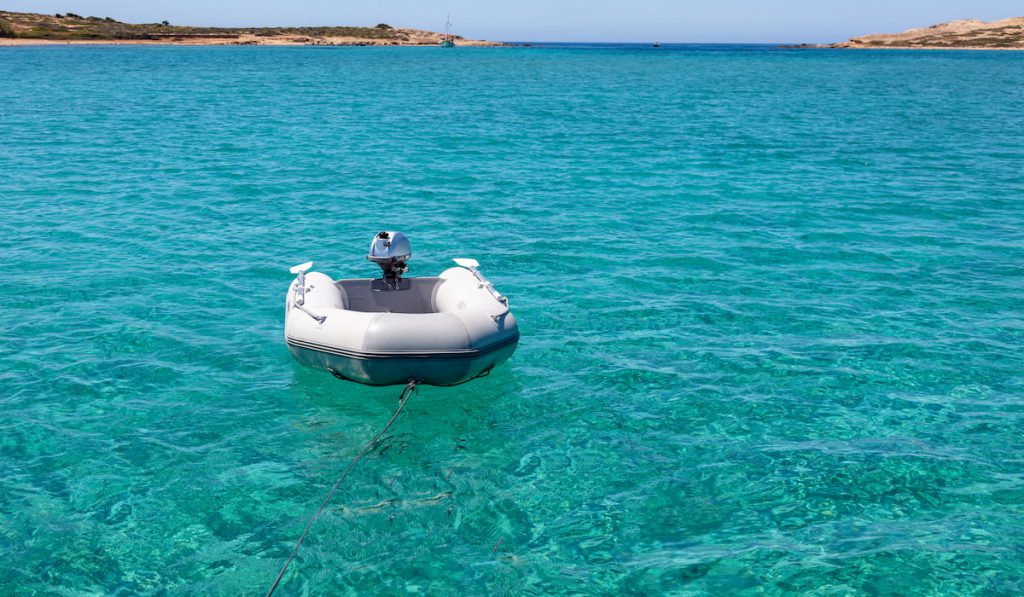
Make Sure It’s Legal to Tow
The first thing you should do anytime you’re boating or attempting to tow something is to find out if it’s legal to tow your tender. Some waterways severely restrict towing of any sort, so you could be fined or get into some other sort of trouble if the authorities spot you towing your dinghy behind your boat.
All you have to do is check online to make sure. If you can’t find the information, you can always call the local authorities to double-check. If you don’t get any clear answers, odds are it’s not going to be an issue.
Make Sure the Dinghy Is Empty Before You Tow
It doesn’t matter how calm the waters are or how short the distance is, your dinghy should be empty whenever you tow it. Take out any paddles, life vests, ropes, coolers, and onboard them to make things safer. Sometimes engines can’t be removed, so tilt it up so the lower part is out of the water.
If your dinghy has an external fuel tank, take that out too. You never know how the dinghy is going to react bouncing around behind your boat, so remove everything just to be safe. The vessel will also be lighter and easier to tow through the water.
Using the Right Gear
If you own a hard-bottomed dinghy that moves through the water with a great deal of stability, and the distance is short, you may be able to get away with tying a single line from your boat to the dinghy. However, just to be safe, we always recommend using a bridle for maximum security.
Your dinghy likely has two D-rings on its bow. That’s where you’re going to connect your lines.
Here’s how you should tie on:
- Attach the ends of your line through the D-rings and make a triangle with the rope that extends a few feet beyond the bow in the direction of your boat.
- Move the bridle (the triangle) through a bowline close to the end of the tow line. This allows for some slippage in the line so the bridle can move as the dinghy’s weight inevitably shifts as you’re towing it. If you can, you can use a small block to stop the ropes from brushing up against each other as they move and it will avoid any sort of chafing.
Now, repeat the same configuration on the towing boat and do what you can do to keep the bridle out of the water. Some people use floats and others attach the bridle to deck cleats.
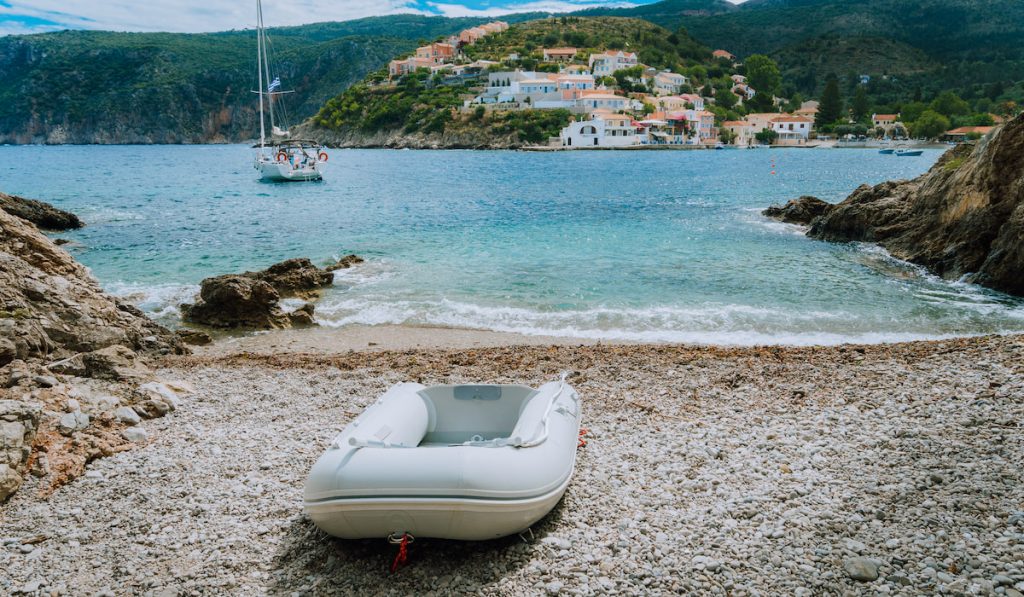
How to Tow Your Dinghy
Once the lines are attached and secure, now you can shift your focus to moving your dinghy through the water efficiently and safely. Your dinghy is going to be moving around a lot as you tow it, so you need to look back frequently to check on it.
Better yet, have someone else on your boat monitoring it constantly so they can let you know if it’s trying to flip or moving around erratically.
One of the most important things you’ll want to do is go slowly enough so that your dinghy doesn’t start taking on water . If water starts to get inside the dinghy, it’s going to be a major drag on your mother ship’s engine.
It can also make it easier for the dinghy to flip, and then you’ll have to stop moving and address the issue before you move on. This is something to certainly consider, especially if there are decent-sized waves where you are or it’s raining at the time. Just a bit of water in the bottom of your dinghy will make a big difference in how hard your boat has to work to tow it.
Of course, the worst-case scenario is if your line breaks under the drag of water weight in your dinghy and you lose connection. Depending on where you are and how many boats are in the vicinity, this can be a major pain.
Take Things Slowly
The best thing you can do is take things slowly and keep an eye on your dinghy as you move through the water. You don’t want your dinghy to flip over, of course, but you also don’t want to be that person that’s dragging a dinghy behind you that’s flying through the air!
Towing of any sort should be done slowly and cautiously. Pay attention to local weather conditions and other boats around you. Go slow!
Remember, only tow your dinghy short distances at low speeds. If you’re going a fair distance or you are in a rush to get somewhere, then take the time and put in the effort to properly store your vessel. You’ll have peace of mind knowing you can move faster and there is a smaller risk of your dinghy getting damaged or left behind.
- https://www.boatus.com/expert-advice/expert-advice-archive/2019/august/how-to-safely-tow-a-dinghy
Similar Posts
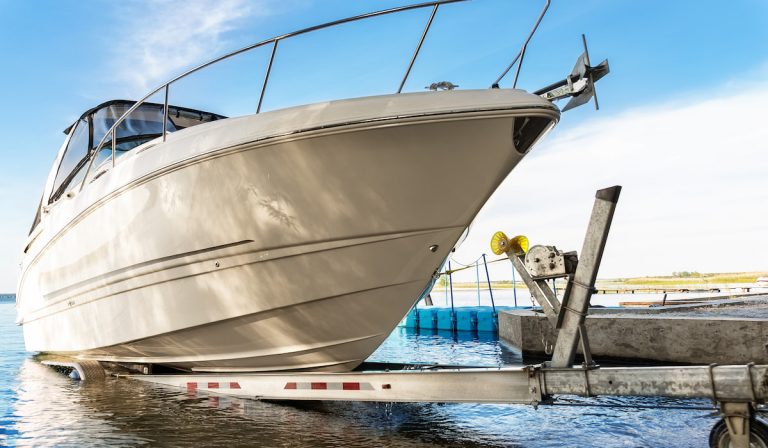
How to Wash Your Boat in the Water
*This post may have affiliate links, which means I may receive commissions if you choose to purchase through links I provide (at no extra cost to you). As an Amazon Associate I earn from qualifying purchases. Please read my disclaimer for additional details.. A boat is a beautiful, often expensive item that deserves to be…
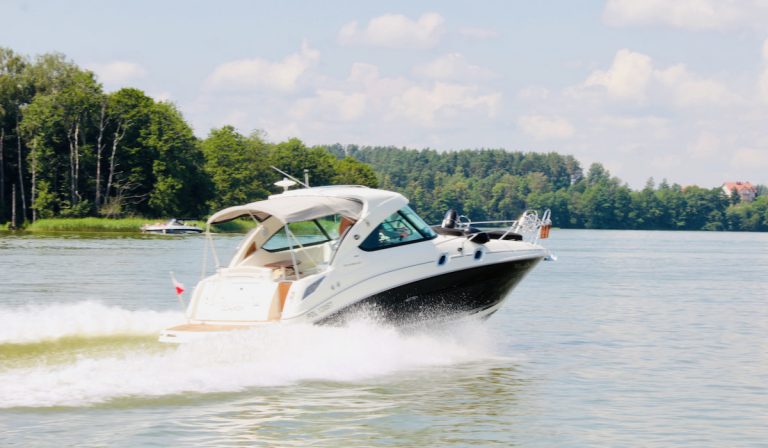
What Are Trim Tabs On a Boat?
*This post may have affiliate links, which means I may receive commissions if you choose to purchase through links I provide (at no extra cost to you). As an Amazon Associate I earn from qualifying purchases. Please read my disclaimer for additional details.. Whether they come with the boat, or you add them aftermarket, trim…
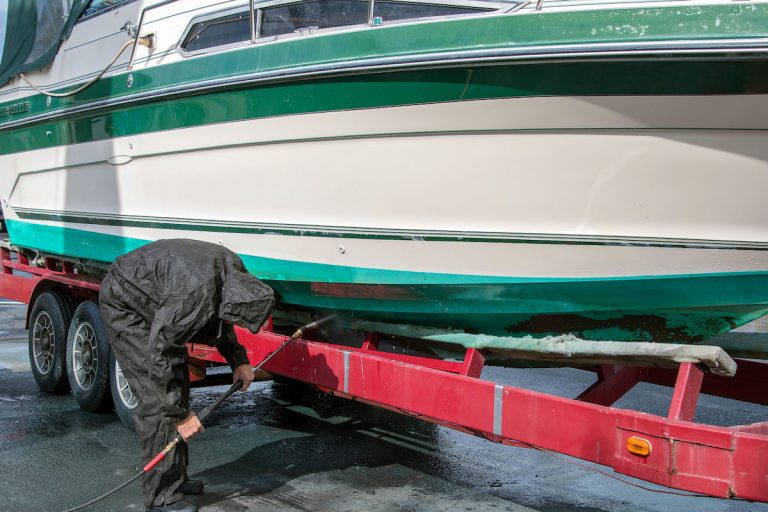
How to Clean an Inboard Boat Engine After Saltwater Use (9 Steps)
*This post may have affiliate links, which means I may receive commissions if you choose to purchase through links I provide (at no extra cost to you). As an Amazon Associate I earn from qualifying purchases. Please read my disclaimer for additional details.. Boating is a ton of fun. Time spent on a boat with…
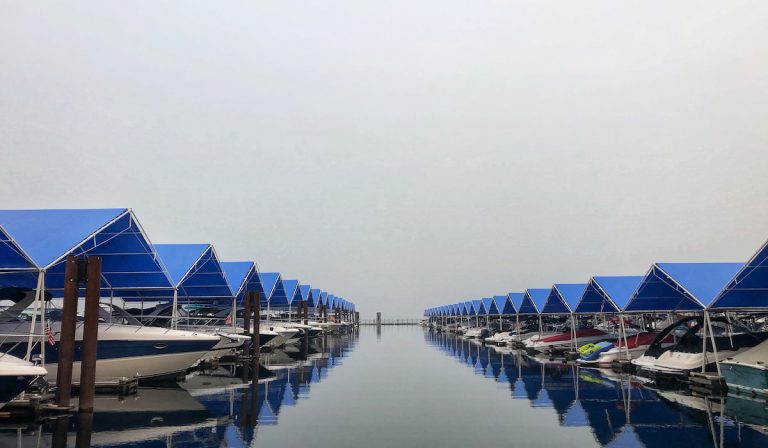
Are Marina Slips with Dock Boxes Worth It?
*This post may have affiliate links, which means I may receive commissions if you choose to purchase through links I provide (at no extra cost to you). As an Amazon Associate I earn from qualifying purchases. Please read my disclaimer for additional details.. Marinas look for ways to make money and create a better customer…
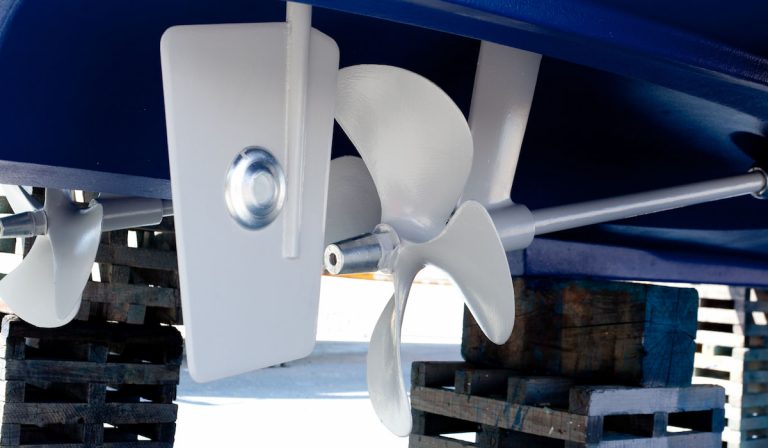
What Are Zincs On A Boat And Do They Need To Be Replaced?
*This post may have affiliate links, which means I may receive commissions if you choose to purchase through links I provide (at no extra cost to you). As an Amazon Associate I earn from qualifying purchases. Please read my disclaimer for additional details.. Boat maintenance may be the most challenging part of owning a boat….
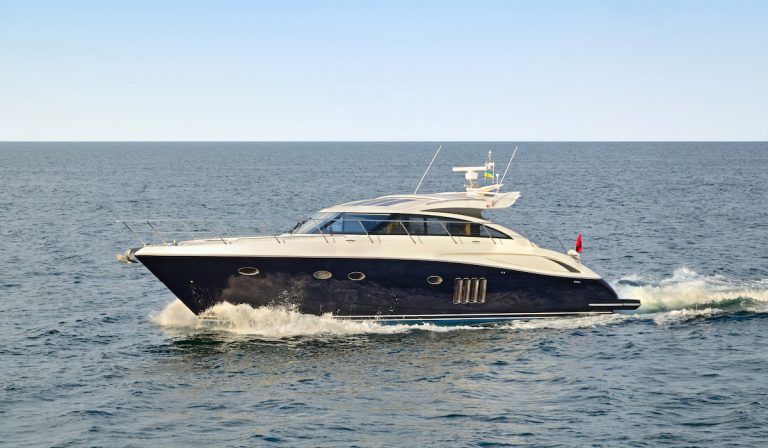
7 Marine Safe Dish Soap Options for Your Boat (Or the Beach)
*This post may have affiliate links, which means I may receive commissions if you choose to purchase through links I provide (at no extra cost to you). As an Amazon Associate I earn from qualifying purchases. Please read my disclaimer for additional details.. The importance of using marine-safe soap for boats cannot be overemphasized. The…
- 2024 BOAT BUYERS GUIDE
- Email Newsletters
- Boat of the Year
- 2024 Freshwater Boat and Gear Buyers Guide
- 2024 Boat Buyers Guide
- 2024 Water Sports Boat Buyers Guide
- 2023 Pontoon Boat Buyers Guide
- Cruising Boats
- Pontoon Boats
- Fishing Boats
- Personal Watercraft
- Water Sports
- Boat Walkthroughs
- What To Look For
- Best Marine Electronics & Technology
- Watersports Favorites Spring 2022
- Boating Lab
- Boating Safety

How to Tow a Dinghy
- By Kevin Falvey
- July 19, 2022
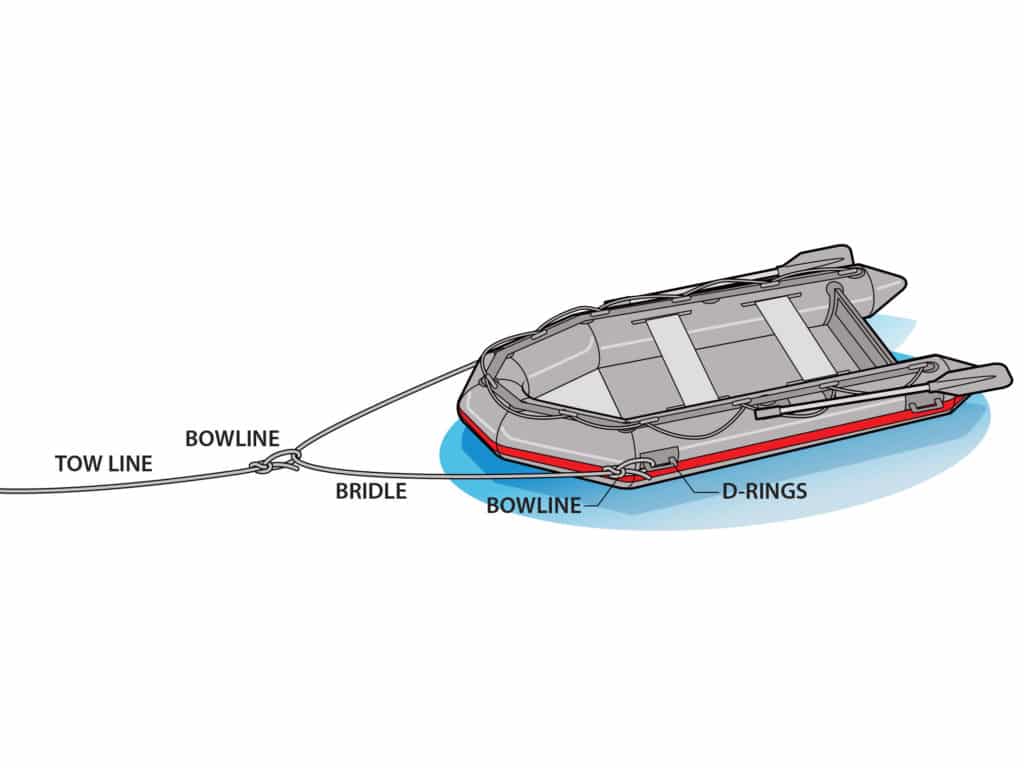
A dinghy proves useful, and not just for cruising. It allows one to anchor deep if a popular spot is too crowded close in.
It’s also fun for taking off to fish, sail or explore. Use the following tips for a safer, easier time while towing a tender.
Start with tying the towline low on the stem, using the bow eye rather than a bow cleat. This keeps the dinghy’s bow up so it rides easier with less chance of stuffing and inhibits the veering. Also consider using a bridle rather than a single towline.
At the dinghy end, a bridle aids in stability, inhibiting the dink from dipping a rail. This is especially true for inflatables, as opposed to hard dinghies. Most inflatables and RIB s feature two low towing rings specifically for use with a bridle. You can make a bridle by tying a length of line about 1.5 times the dinghy’s length between the two D-rings. Pass the main towline—or painter—around the resulting loop created by the bridle and tie using a bow line. In this way, the bridle slips through the bow line underway, self-centers and keeps the load even on the rings. Tow bridles can also be bought.
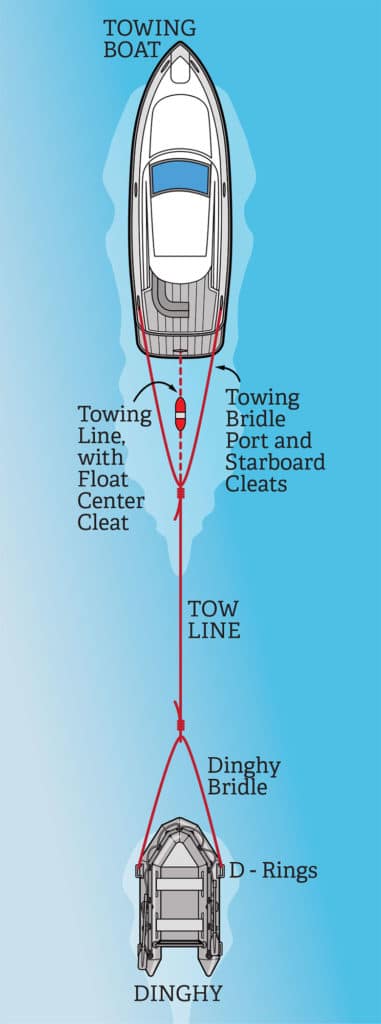
At the boat end, a bridle spreads the load over multiple fittings; if your dinghy swamps underway, the load will be substantial and sudden. A bridle also helps keep the dink centered in the wake. Using a dock line, cat’s-paw the loop through one stern cleat, slip a galvanized dock ring onto the line, then cleat off the bitter end to the opposite stern cleat. Tie the towline onto the ring. Wah-lah! Polypropylene line is often chosen because it floats and comes in bright, easy-to-see colors that help keep it out of propellers.
How far back should you tow a dinghy? In calm water, about two waves back. If it gets rough, adjust the length of the towline so that when the boat crests a wave, so does the dinghy. Remember: Syncing the boat and tow helps avoid sinking the boat you tow . Bring the dinghy in close for docking, but don’t chop the throttles, lest your dinghy slams into your transom.
How fast should you tow a dinghy? The slower you go, there’s less chance of the dinghy taking on water. If you are going to plane with your dinghy, tow it so it rides behind the rooster tail, the point at which your boat’s chine wakes converge. A planing dinghy can lose buoyancy and become unstable in aerated water. Never go so fast that your dinghy catches air.
We recommend removing outboards and gear. However, some weight aft, such as tied-down water jugs, help to keep the bow up. Towing a length of line behind, like the tail on a kite, will often cure a dink that wants to wiggle and wander.
Carrying a dinghy aboard is the preferred solution of long-range cruisers. For shorter trips, apply these tips.
- More: August/September 2022 , How-To , Seamanship
More How To

I Learned About Boating From This: Capsize, Rescue and Lessons Learned
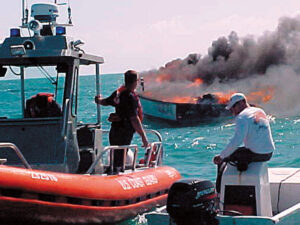
Should You Abandon Ship During a Boat Fire?

38 Top Make-Ready Tips for the Spring Boating Season
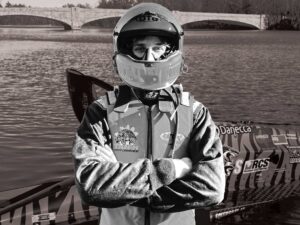
On Board With: Andrew Robbins

Boat Test: 2024 Regal 38 Surf
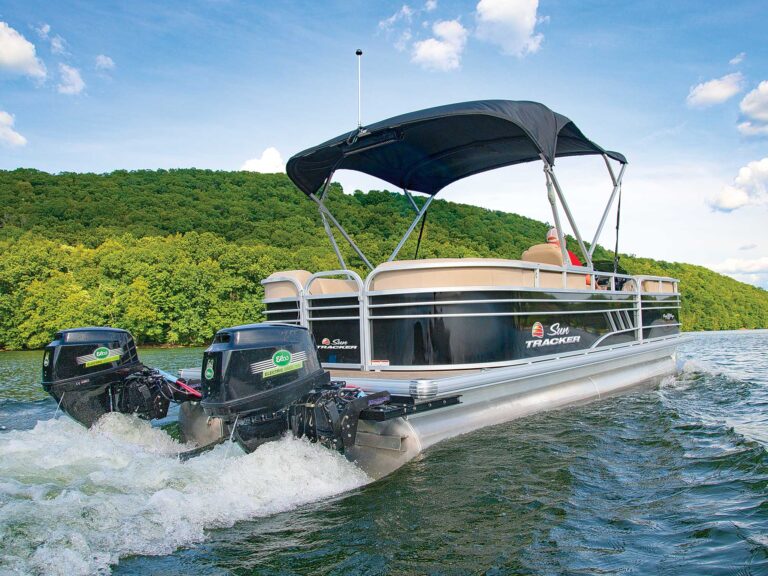
Using Hydrofoils to Improve Boat Performance
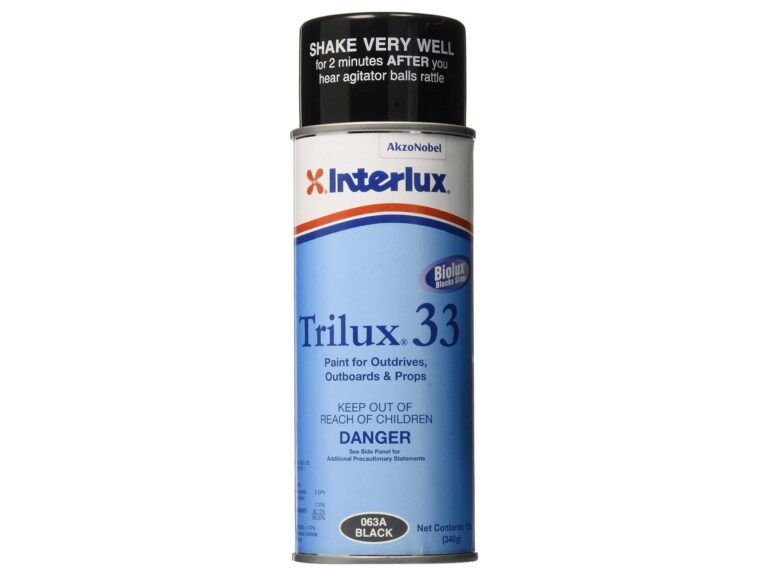
We Test Interlux Trilux 33 Aerosol Antifouling Paint

- Digital Edition
- Customer Service
- Privacy Policy
- Cruising World
- Sailing World
- Salt Water Sportsman
- Sport Fishing
- Wakeboarding
Many products featured on this site were editorially chosen. Boating may receive financial compensation for products purchased through this site.
Copyright © 2024 Boating Firecrown . All rights reserved. Reproduction in whole or in part without permission is prohibited.

- Forums New posts Unanswered threads Register Top Posts Email
- What's new New posts New Posts (legacy) Latest activity New media
- Media New media New comments
- Boat Info Downloads Weekly Quiz Topic FAQ 10000boatnames.com
- Classifieds Sell Your Boat Used Gear for Sale
- Parts General Marine Parts Hunter Beneteau Catalina MacGregor Oday
- Help Terms of Use Monday Mail Subscribe Monday Mail Unsubscribe
Towing a dinghy
- Thread starter circa1971la
- Start date Jan 1, 2023
- Forums for All Owners
- Ask All Sailors
circa1971la
I know there’s many opinions about this but wondering what people suggest here. Sailing a 25’ to Catalina. Considering towing my 8’Mercury (without the outboard attached)as not much storage for it on deck.. I’d plan to tow it over in calm conditions likely but the issue is there’s just one D-ring on the bow. So.. 1) Would you advise running two lines from the bow in a “V-configuration“ to each side of the sailboat transom? 2) Should the dingy be snug against the stern to keep it more contiguous or let out a distance? There‘s a spade rudder so no interference with a rudder on the stern Thank you
Sailfanatic
Of course there are going to be contradictory views. I used to sail to Block Island with my Peanut Pram in tow. there was a bridal on the pram and it was very light. No motor. Oars were stuffed under the seats. Maybe jammed is a better word. Anchor ,rode and emergency kit attached to the transom. No problem. Even in the afternoon sea breeze with waves in the 4+ range there was no problem. I towed it in the second wake wave on the downside. Even if the pram would get spun a little on a wave it would slide right back to its place. That was my experience. Ocean passages would be different.
Thank you so much.. also does it really slow down the boat by 1kt or are there just too may variables to estimate that?
Basically too many variables. Mine slowed the boat some mostly under power. Sailing, if the wind was over 12 kts. or so not very much. I forgot to include that the two problems I had were: A violent thunderstorm with torrential rain. I had to bring it up and bail it out. And a time with a large Silvertron passed way close to us and his wake swamped the pram. We had to bail it while I looked for my flare gun.
We have towed our dinghy for literally thousands of miles. It is a small RIB (8') and is towed with a bridal. The bridal helps it to track behind the boat. Typically the dinghy is towed on top of the second stern wave. Once we are under way the painter is adjusted to allow the dinghy to ride on that wave. In a harbor or close quarters the painter is taken up so the dinghy rides close to the stern. This prevents the painter from getting wrapped around the prop and keeps the dinghy out of the way. Tracking will in part depend on the hull of the dingy. Expect a flat bottom inflatable to track poorly while a RIB will track pretty well. We did put the dinghy on the foredeck when we crossed to the Bahamas and on the return trip. Towing the dingy will slow the boat, how much depends on the dinghy, the size of the boat towing, and wind speed. When motoring it is not noticeable. Once the wind is strong enough to drive the boat at or near hull speed the dingy has no effect. In lighter air the dingy will slow the boat down.
Davidasailor26
We towed an Achilles inflatable for many years on a reasonably protected bay. The only time it was any trouble was during one particularly bad summer thunderstorm when it started flying in the wind behind the boat. No serious damage was done though. We never towed with the motor on. Some others who did lost the dinghy or dunked the motor in that storm. Ours had tow rings on each side for a bridle. We would let it out several feet behind the boat to where it could ride downhill on the face of a stern wave consistently. We lost some speed with it, but we’ll under a knot. I’d estimate about 0.5 kt in most conditions.
Hayden Watson
- much lower drag which results in faster speed through the water whether sailing or motoring.
- total control of the dink.
- Can stop and reverse without concern about sucking the line into the prop.
Attachments

a what?? 'a large Silvertron passed way close to us'
Been towing our small Mercury roll up with the outboard attached in the raised position for about ten years with no issues. Our roll up has two D rings and a short bridle and then a single tow line. When we approach the dock we have the bow of the dinghy right up to our stern on the outermost stern cleat so that we can reverse without getting the tow line wrapped around the prop. Tow line has floats also. In a tight docking situation we tie it to the outside mid ship cleat with a short lead allowing the dinghy just enough line to swing in either direction. As to slowing the boat, I believe it unfortunately provides a measurable reduction in speed when motoring or in light airs. Try pulling it in by hand while under way at hull speed and you will feel about a fifty pound drag. If someone is really curious about the effect of that drag on speed, please perform the following: Tow the dinghy and note the steady GPS speed. Toss the tow line overboard and note the change in GPS speed when it stabilizes. Record results. Report here for the rest of us. Of course, go back and retrieve your dinghy.
RoyS said: Tow the dinghy and note the steady GPS speed. Toss the tow line overboard and note the change in GPS speed when it stabilizes. Record results. Report here for the rest of us. Of course, go back and retrieve your dinghy. Click to expand
Kings Gambit
As I’ve often remarked here, I am not a fan of towing the dink. But as others have explained it can be, and has been, a viable means of transporting one, Like every thing else in boating, “it depends.” The chief downside risk is losing it, which might stem from any one of several, or two combined, unhappy events. If you must always tow; that is, you cannot bring it aboard to the foredeck, you should be mindful of the conditions that you could face while away from harbor, etc. When I do tow my 9.5’ RIB the outboard is removed. I use two tow lines with separate attachment to the towing eye. If one parts, the other is still attached, etc. I use only floating tow lines of polypropylene or other cord material that floats. I use soft shackles, or with the end of the tow line passed through the towing eye of the dink then through an eye splice in the tow line to secure. If eye thimbles are used they are the plastic ones. The floating lines reduce the risk of fouling the prop or rudder from sucking them under. However, it’s still best to pull the dink close to the boat and get the lines mostly out of the water when backing or trying to maneuver the boat in close settings. As mentioned, you can lessened the towing drag some by riding the dink on a stern wave, or just inside the second one so it’s actually pushing the dink along, somewhat. I usually keep mine fairly close, however. Control slewing by adjusting the independent tow lines. I recommend not using the D-rings on the chambers as the towing “strong point”; use the eye on the bow of the dink. Remove the oars when towing, and anything else that might interfere with managing the dink in poor conditions, such as an outboard! If you must tow with outboard attached, don’t depend only on the mounting set screws to secure it. Use a safety lanyard to clip it to the dink as back up. Good luck with it!
RoyS said: Try pulling it in by hand while under way at hull speed and you will feel about a fifty pound drag Click to expand
Morgan donor
Your towing bridal might best start at the transom and work it's way forward on both sides. Capture each D ring with at least a loop to spread the load, leading to a single painter forward. With the transom taking some of the strain you almost can't lose the boat. Don't rely on one glued on piece of rubber to take the tow load. I know a guy....!
Morgan donor said: Don't rely on one glued on piece of rubber to take the tow load. I know a guy....! Click to expand
- This site uses cookies to help personalise content, tailor your experience and to keep you logged in if you register. By continuing to use this site, you are consenting to our use of cookies. Accept Learn more…
Storing and transporting a dinghy
You can leave a dinghy on its dolly at the beach or in a boat park or marina and transport it by road on a trailer. For peace of mind and for everyone's safety, the boat should be tied down as securely as possible, with top and bottom covers for maximum protection.
STORiNG A DINGHY
When leaving a dinghy unattended, you may need to remove sails, foils, and all loose fittings—dinghy gear is expensive to replace and theft does unfortunately happen. Pull halyards tight before you leave the boat—when it is windy, people do not want to hear the unpleasant noise of wires banging against aluminum masts. Leave the drain bung open to allow air to circulate inside the hull. It makes good sense to remove the bung or carry spares, in case a neighboring boat owner decides to "borrow" it.
Always use a good-quality top cover to protect the dinghy from ultraviolet light and rain, and make sure it is securely attached to the boat—a "boom-up" design will help drain rainwater away from the dinghy. A bottom cover will provide further protection from damage and is always recommended when transporting a dinghy on a trailer.
Dinghies can get blown over by strong winds, so tie your boat down to ground anchors as an added precaution. Beware of neighboring boats getting blown onto your dinghy in particularly windy weather. It is well worth making sure that your insurance policy covers this kind of accident.

USING A BOAT COVER
Use a cover that will provide full protection from ultraviolet light and rain, with under-hull straps to ensure it is securely held in place.

storing and transporting a dinghy 167
TRAILING A DINGHY
You can transport a dinghy by loading it on to a purpose-made trailer, which you attach to your car. Modern combi-trailers allow the boat to stay on its trolley, which slides on and off the road base. Check the light board is properly attached and fully functional. The dolly must be locked to the road base and the trailer locked on to the tow hitch with an additional security wire. Ensure that the boat and mast are securely tied down. Any loose equipment, such as the boom, should be taped or tied in position for safety reasons. Put padding (carpet or thick rubber) under ropes, straps, and the mast base to prevent rubbing and abrasion. Always carry a spare trailer wheel and a set of tools in case of a puncture or bearing failure. Check the trailing regulations governing the weight, length, and width of the trailer.
READY TO ROLL
When transporting a dinghy, make sure that the mast will clear the roof of your car and there is no large overhang at the transom.

DINGHY PARK
Bow-down is the most stable position in which to store your dinghy, but bow-up will allow rainwater to drain out through the transom or bung holes.

Continue reading here: Dinghy maintenance
Was this article helpful?
Recommended Programs

Myboatplans 518 Boat Plans

Boat Alert Hull ID History Search

3D Boat Design Software Package
Related Posts
- Mooring a dinghy - Sailing Techniques
- Lets Lie AHull - Heaver Weather Sailing
- Using Your Dinghy - Sailing Fast
- Rigging a singlehanded dinghy
- Tacking and jibing a catamaran
Readers' Questions
Where do you store dinghy sailboats?
Dinghy sailboats can be stored in a variety of places depending on the availability of space and the individual's preferences. Here are some common storage options for dinghy sailboats: Garage or shed: If you have enough space, you can store the dinghy sailboat in a garage or shed to protect it from the elements and keep it secure. Boatyard or marina: Many boatyards and marinas offer storage facilities where you can keep your dinghy sailboat on a trailer or on dry racks. These facilities often provide additional services such as launching, maintenance, and security. Yacht club: If you are a member of a yacht club, they may have designated storage areas for dinghy sailboats that you can utilize. Off-site storage facility: If you don't have space at home or access to a boatyard, you can rent a storage unit at an off-site facility specifically designed for boats and other recreational vehicles. Dock or mooring: If you have access to a waterfront property, you can store the dinghy sailboat on a dock or a mooring buoy, ensuring it is easily accessible for launching and retrieval. Remember to consider factors such as convenience, security, cost, and local regulations when choosing the storage option for your dinghy sailboat.
Can you run your dingy on to a beach?
Yes, a dinghy can be run onto a beach. Dinghies are lightweight and small watercraft that are designed to be easily maneuvered and transported. Their shallow draft allows them to be easily beached or launched from a shoreline. However, it is important to consider factors such as the tide, waves, and the condition of the beach to ensure a successful beach landing.
Can a mirrro dinghy rest on its side?
No, a Mirror dinghy cannot rest on its side. As it is a small sailing dinghy with a flat bottom and a keel, it will not balance or stabilize properly when placed on its side. It is designed to rest upright on the flat bottom or be supported on a cradle or trolley when not in the water.
How to put a dinghy on a marina trolly?
To put a dinghy onto a marina trolley, follow these steps: Locate a suitable marina trolley: Look for a trolley specifically designed to transport dinghies or small boats. These trolleys usually have large inflatable or solid wheels for easy maneuverability. Position the trolley: Place the trolley close to the water, ideally on a ramp or a flat surface that allows you to slide the dinghy onto it smoothly. Prepare the dinghy: Remove any loose gear or personal items from the dinghy. Make sure the dinghy is properly deflated or emptied of any water to reduce weight and ensure easy handling. Secure the trolley: Check if the trolley has the necessary straps, hooks, or brackets to secure the dinghy. If not, use additional ropes or straps to ensure the dinghy stays in place while being transported. Lift and slide the dinghy: First, ensure you have enough people to lift and carry the dinghy safely. Lift the dinghy together and carefully place it onto the trolley, aligning the keel with the trolley's centerline. Secure the dinghy: Use straps or ropes to secure the dinghy to the trolley. Cross the straps over the dinghy and tighten them to keep the boat in position during transportation. Ensure the straps are tight enough to prevent movement but not overly tight to damage the dinghy. Check for stability: Give the dinghy a gentle push to ensure it is secure on the trolley. If there is any movement, adjust the straps or ropes as needed to achieve stability. Move the trolley: Once the dinghy is securely attached to the trolley, push or pull the trolley to the desired location. Use caution while moving and watch for any obstacles or uneven surfaces. Always follow the marina's guidelines and regulations regarding the use of trolleys and dinghies to ensure a safe and respectful experience in the marina.
How to transport a wooden mirror dinghy?
Transporting a wooden Mirror Dinghy can be done in a few simple steps. Here's a guide on how to do it: Prepare the Dinghy: Remove any loose or detachable parts from the Mirror Dinghy, such as the mast, boom, rudder, and tiller. Securely pack and store these parts separately. Clean the Dinghy: Give the Dinghy a good cleaning to remove any dirt or debris. This will help protect it during transportation. Protect the Dinghy: Place a layer of bubble wrap or foam padding on the bottom of the Dinghy to protect the hull during transportation. Securely fasten the bubble wrap or padding with tape or rope. Cover the Dinghy: Use a boat cover or tarp to protect the Dinghy from dust, moisture, and road debris. Ensure that the cover or tarp is securely fastened to avoid wind damage during transportation. Choose a Suitable Trailer: Use a trailer specifically designed for boat transportation. Make sure the trailer is large enough to accommodate the Mirror Dinghy. Secure the Dinghy on the Trailer: Place the Dinghy on the trailer, aligning it properly on the keel. Ensure that the Dinghy is centered and balanced, preventing any shifting during transportation. Use sturdy straps or ropes to secure the Dinghy to the trailer. Tie-down points or hooks on the trailer can be used to anchor the Dinghy securely. Secure Loose Parts: Place all the loose parts, such as the mast, boom, rudder, and tiller, inside the Dinghy. This will prevent them from getting lost or damaged during transportation. You can also secure them separately on the trailer if space allows. Double-check Everything: Before hitting the road, thoroughly inspect the Dinghy, trailer, and straps to ensure that everything is securely fastened and properly aligned. Transport: Drive with caution and avoid sudden accelerations, braking, or sharp turns. Staying within legal speed limits is important for the safety and security of the Dinghy. Unloading: Once you reach your destination, carefully unload the Dinghy from the trailer. Reattach all the loose parts, ensuring everything is properly connected. By following these steps, you can safely transport a wooden Mirror Dinghy to your desired location.
Can i tie up a dinghy at onset beach?
Yes, you can tie up a dinghy at Onset Beach. However, it's always a good idea to check with local authorities or the management of Onset Beach to ensure that there are no specific regulations or restrictions on tying up dinghies in that area.
Can you transport a moped in small dingy, boat forums?
Yes, it is possible to transport a moped in a small dinghy or boat, as long as you have enough space and the necessary equipment to secure and protect the moped during transit. However, it is important to keep in mind the weight restrictions and stability of the vessel when carrying additional cargo. It is recommended to consult the boat manufacturer's guidelines and use proper straps or tie-downs to safely secure the moped during transportation. Additionally, you may find more specific and detailed information on boat forums where experienced boaters can provide advice based on their own experiences.
How to transport a sailing dinghy on a roof bars?
Attach two tie-down straps at each end of the dinghy, running through the tie-down loops on the roof bars. Make sure the straps are securely tightened and cinched down so that the dinghy is held firmly in place. If possible, use two ratchet-style straps in a criss-cross pattern over the dinghy for additional stability. Use additional tie-downs such as webbing straps to prevent the dinghy from sliding off the roof bars. If the dinghy is too long to fit across both roof bars, you can use a set of cross-bars, or a roof rack, to span the distance between the roof bars, and secure the dinghy across this section. Make sure to secure the dinghy with plenty of padding and foam to prevent scratching or denting of the vehicle. Once the dinghy is secure on the roof, check all tie-downs to make sure they’re secure, and check the dinghy periodically during the trip to make sure everything is in place and secure.
What is the best way to transport a spar and mast for a dingy sailboat?
The best way to transport a spar and mast for a dinghy sailboat is to break it down into its smallest components, such as the base, mast, and spar, and secure them in a bag or box for easy transportation. This will help to reduce the size and weight of the parts, making them easier to transport. If possible, consider using a trailer or vehicle to transport the pieces in order to help protect the parts from bumps and scratches. Additionally, the mast should be secured in a special mast carrier to ensure it does not get bent or damaged in transit.
How to store a rubber dinghy on the back of your boat?
Retie the mooring lines to the cleats on the side of the boat. Move the dinghy close to the stern of the boat. Secure the stern of the dinghy to the back transom of the boat using two or three strong mooring lines. Secure the bow of the dinghy to a looped line or a bow cleat on the front of the boat. Place fenders between the dinghy and the boat to protect both from chafing. If the dinghy is large, rig a sling underneath the dinghy and attach to the base of the mast. This will act as an extra secure point of attachment. If the dinghy is on the heavier side, consider installing lifting eyes or short straps to the sides of the dinghy for easy lifting. Lastly, check the lines, fenders, and lifting straps for tightness every time you use the dinghy.
Can you store a dinghy on its side?
It is possible to store a dinghy on its side, but it is not recommended. The best practice for storing dinghies is upright in an area that is well-protected from the elements. This will help ensure its structural integrity is maintained for as long as possible.
Why is dinghy moving around alot ion trailer?
This could be caused by a number of things, such as an improperly balanced trailer, incorrect trailer tire pressure, poor quality trailer tires, or worn trailer suspension components. If the trailer is weighted improperly, the uneven distribution of weight can cause the dinghy to move around while it is being towed. Improper strap or chain tension may also cause the dinghy to move around on the trailer. It is important to ensure that the trailer is properly balanced and the trailer tires are properly inflated before towing the dinghy. Additionally, any straps or chains used to secure the dinghy to the trailer should be tightly secured.
How to transport dinghy in pickup trucks?
Secure the boat onto the bed of the pickup truck. Use at least four tie-down straps and secure them to the boat and the truck bed. Make sure the straps are very taut and secure so the boat does not move during transport. Place the outboard motor in the box of the truck or on the floor in the back seat. You should preferably secure it to the inside of the vehicle using straps. Place any other accessories related to the dinghy in the cab of the truck or in the bed. Be sure to secure any loose items so they don't move around during transit. If the truck bed is not covered, cover the boat with a tarp to keep it protected from the elements. Drive slowly and be aware of your surroundings. The extra weight of the boat means the truck will stop more slowly and take longer to accelerate.
How best to transport a topper sailing dinghy?
The best way to transport a topper sailing dinghy is by trailer. If you don't have a trailer, you can use a roof rack and some straps to secure the dinghy to your vehicle or use a dinghy trolley and pull it by hand. If you have access to a pickup truck, it is also a convenient way to transport a topper sailing dinghy.
How to transport a dinghy?
A dinghy can be transported by attaching it to a larger sailboat or motorboat, or by towing it with a car or truck using a trailer.
Can you tow dinghy van mast?
Yes, many vehicles are equipped with a tow hitch, allowing them to tow a dinghy van mast with relative ease.
How to transport a mast?
To transport a mast, you can use a trailer with a tall enough A-frame to fit the mast securely. Alternatively, you can enlist the help of a crane service to hoist the mast on to a flatbed truck or a low loader. Make sure you use webbing or rope to secure the mast to the trailer or truck and drive carefully to your destination.
What happens to a dinghy if you leave the bung in?
If a dinghy is left with the bung in, the dinghy will become full of water and sink.
How to transport a dinghi?
A dinghy can be transported by either towing it behind or on a trailer or a combination of both. It can also be transported using a crane or a hoist.
How do you transport dingheys?
Dinghies can be transported by trailer, truck, or boat.
How to store a sailing dinghy?
There are several ways to store a sailing dinghy, depending on the available space and resources. Here are some options: Boat storage facility: Consider renting a space in a boat storage facility or marina. These facilities provide security, protection from the elements, and access to amenities such as hoists or docks for launching. Make sure to inquire about the rates and any additional services offered. Dry storage: If you have enough space on your property, you can store the dinghy on land. Ensure the area is flat, well-drained, and away from any potential hazards. Construct a boat cradle or use boat stands to properly support the hull and avoid damage. Cover the boat with a tarp or boat cover to protect it from the weather. Garage or shed: If you have a large enough garage or shed, you can store the sailing dinghy indoors. Make sure there is sufficient space and access to maneuver the boat. Place it on a sturdy dolly or boat trailer to make it easier to move around if needed. Yacht club or sailing center: Some yacht clubs or sailing centers offer storage options for members' boats. These facilities may have dedicated dinghy racks or storage areas. Inquire with local clubs or sailing centers to see if they offer such services. Mooring: If you have access to water, you can store the dinghy on a mooring. This is a permanent anchor set in the water where you can attach the boat. Ensure that the mooring is securely anchored and that the boat is properly secured to it. Remember to properly prepare the boat for storage by removing any gear or equipment, cleaning it thoroughly, and covering it or sealing it with a boat cover. Regularly inspect and maintain the dinghy to ensure it remains in good condition during storage.

- Find A School
- Certifications
- North U Sail Trim
- Inside Sailing with Peter Isler
- Docking Made Easy
- Study Quizzes
- Bite-sized Lessons
- Fun Quizzes
- Sailing Challenge

Towing A Dinghy?
By: Zeke Quezada, ASA Cruising Tips
I am going to get it out of the way immediately. I once fouled a prop with a towline. It took about an hour in Gustavia harbor to get the mess of braided nylon out from under one of two props on a 48-foot catamaran. It was a rooking mistake. However, it is a common issue that could have been prevented.
American Sailing has published Going Ashore Made Easy to help you use a dinghy properly and safely. This book will cover the essential information that will be taught as part of the Dinghy & Outboard endorsement for the American Sailing Association (ASA 116).
Experience and a sailing education prepare you for a bareboat charter or offshore cruising. The dinghy is an essential piece of equipment for cruisers on sailboats and powerboats and having the knowledge of proper operation is vital for the safety of yourself and others. One of the tasks that you will encounter is the storage and towing of your dinghy while on a bareboat charter or coastal cruise.

Tips on towing a dinghy from Going Ashore Made Easy: The Essential Dinghy & Outboard Manual.
Whether you should tow your dinghy for short distances depends on numerous factors that include weather conditions, the type and size of the dinghy as well as the type of boat doing the towing. It is a good idea to have a general sense of best practices in order to make an informed opinion about the procedure for towing a dinghy.
Painters are generally not long enough to serve as towlines. Towlines should be long enough so the dinghy rides about 2 waves behind the boat. That distance will differ with sea conditions and your cruising speed, but a 30-50 ft towline is a good approximation. A typical dinghy tow line might be 40 feet of 7/16” diameter line. Use a towline rated at least 5 times the weight of the dinghy (and motor) being towed.
Outboard or Not?
In rough seas, a towed dinghy can easily be flipped or swamped. Righting an overturned dinghy is no easy feat, and it’s made even more difficult and costly if the outboard motor is submerged in seawater. Unless conditions are absolutely benign, you’d be well advised to remove the outboard motor before towing your dinghy. If you choose to leave the outboard mounted, be sure to tip it up to prevent excessive drag. In any case, close the vent on the fuel tank.
Towing Different Dinghy Types
A hard dinghy usually tracks well in calm water; attach the towline to the towing eye on the bow, preferably 6 inches or more below the stem to ensure the bow rides high. Inflatable dinghies (especially soft inflatables) don’t track as well and are best towed with a towing bridle that connects to D-rings on either side of the bow. The bridle spreads the load and helps keep the dinghy straight when towed.
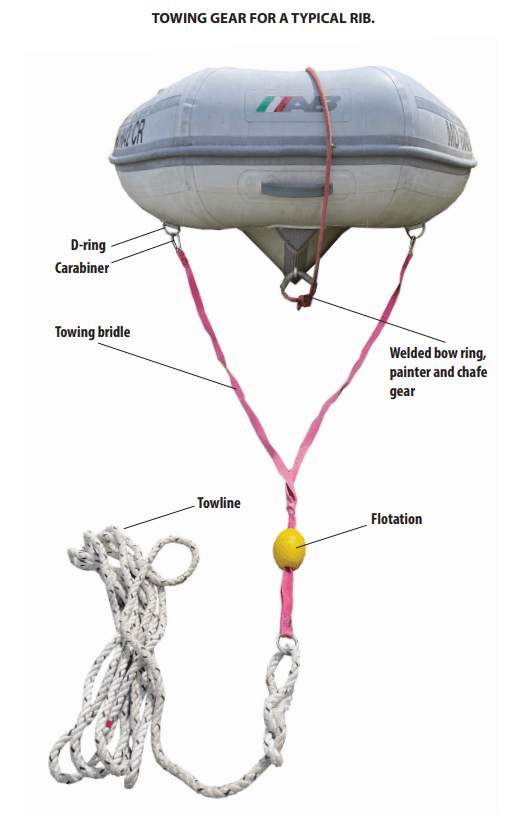
Basic Towing Guidelines
Use this basic checklist for safely towing a dinghy:
- Remove loose gear to prevent loss.
- Close the vent on the fuel tank.
- If sea conditions are not gentle, remove the outboard motor.
- If the motor remains mounted, tilt it up to prevent drag.
- Ensure you have a sturdy towline and/or bridle.
- Attach the towline to the dinghy’s centerline towing eye, or …
- Attach a towing bridle to the D-rings on either side of an inflatable dinghy’s bow. Tie the towline securely to the towing boat.
- Assess the best towing position for your cruising speed and sea conditions. Adjust the line to keep the boat and dinghy in step with the waves, or keep the dinghy in step with your wake.
- Towed dinghies require constant monitoring.
- Never put passengers in a dinghy being towed.
- Remember to slow down and shorten the towline or bring the dinghy alongside before mooring, anchoring or docking.
For more extensive towing tips as well as operations and storage take a look at Going Ashore Made Easy: The Essential Dinghy & Outboard Manual

Related Posts:

- Learn To Sail
- Mobile Apps
- Online Courses
- Upcoming Courses
- Sailor Resources
- ASA Log Book
- Bite Sized Lessons
- Knots Made Easy
- Catamaran Challenge
- Sailing Vacations
- Sailing Cruises
- Charter Resources
- International Proficiency Certificate
- Find A Charter
- All Articles
- Sailing Tips
- Sailing Terms
- Destinations
- Environmental
- Initiatives
- Instructor Resources
- Become An Instructor
- Become An ASA School
- Member / Instructor Login
- Affiliate Login
- BOAT OF THE YEAR
- Newsletters
- Sailboat Reviews
- Boating Safety
- Sailing Totem
- Charter Resources
- Destinations
- Galley Recipes
- Living Aboard
- Sails and Rigging
- Maintenance
- Best Marine Electronics & Technology

Dinghy Storage on a Sailboat
- By Dan Spurr
- Updated: August 28, 2020
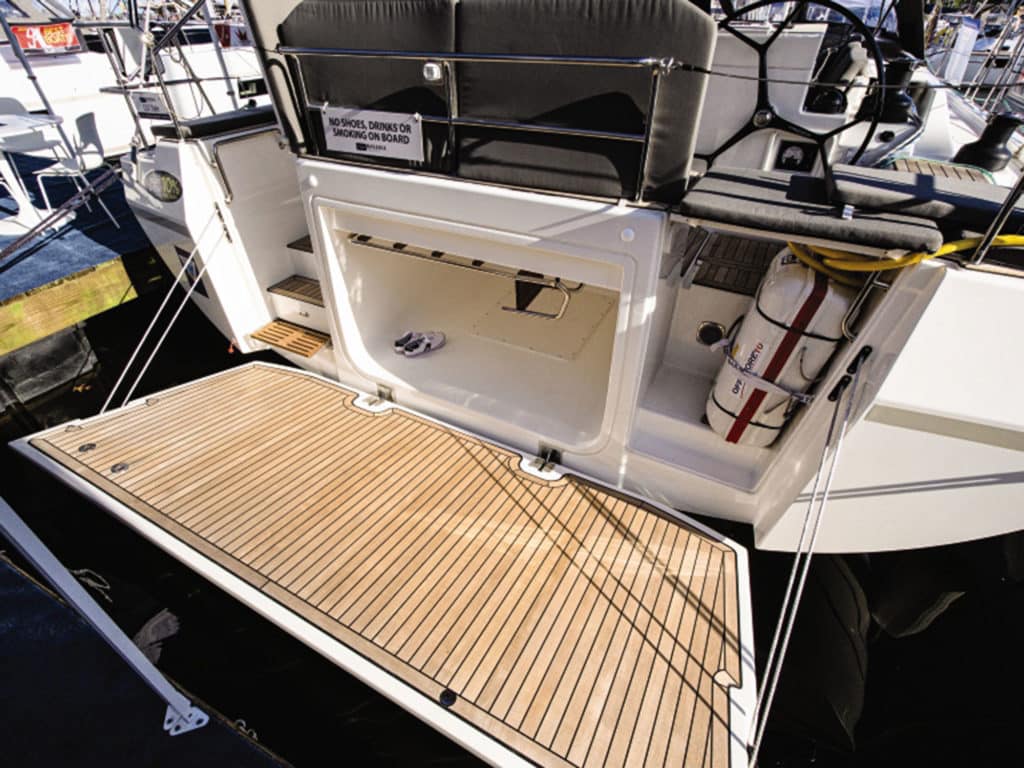
During this past October’s Boat of the Year competition at the US Sailboat Show in Annapolis, Maryland, the judges became quite familiar with the concept of “garages.” That is, a large stowage area under the cockpit for dinghies as long as 10-plus feet, as well as hard-bottomed RIBs with sizable outboard motors, and even consoles. They are accessed by fold-down doors or transoms that double as swim or launch platforms. During our evening deliberations, we three BOTY judges —Ralph Naranjo, Ed Sherman and me, along with CW editors Mark Pillsbury and Herb McCormick—began to speculate what other developments in carrying dinghies might have emerged alongside this particular innovation.
At the risk of being anticlimactic, the best answer is: none.
The other options, beyond the garage, are familiar, but there is not one unanimous choice that suits all sailboats. The decision tree begins with the mothership, and the best choice is dictated mostly by its size and design. So if you haven’t bought your cruising sailboat yet, eye each candidate with its suitability for carrying the dinghy . But if you’re committed to your current boat, you’ll have to make do.
This maneuver is OK for sheltered waters but not advisable in rough conditions, even on coastal forays. There must be a provision for securing the dinghy out of the water. If it fills with water, you might have to cut it loose before it endangers your boat. Losing a dinghy is painful.
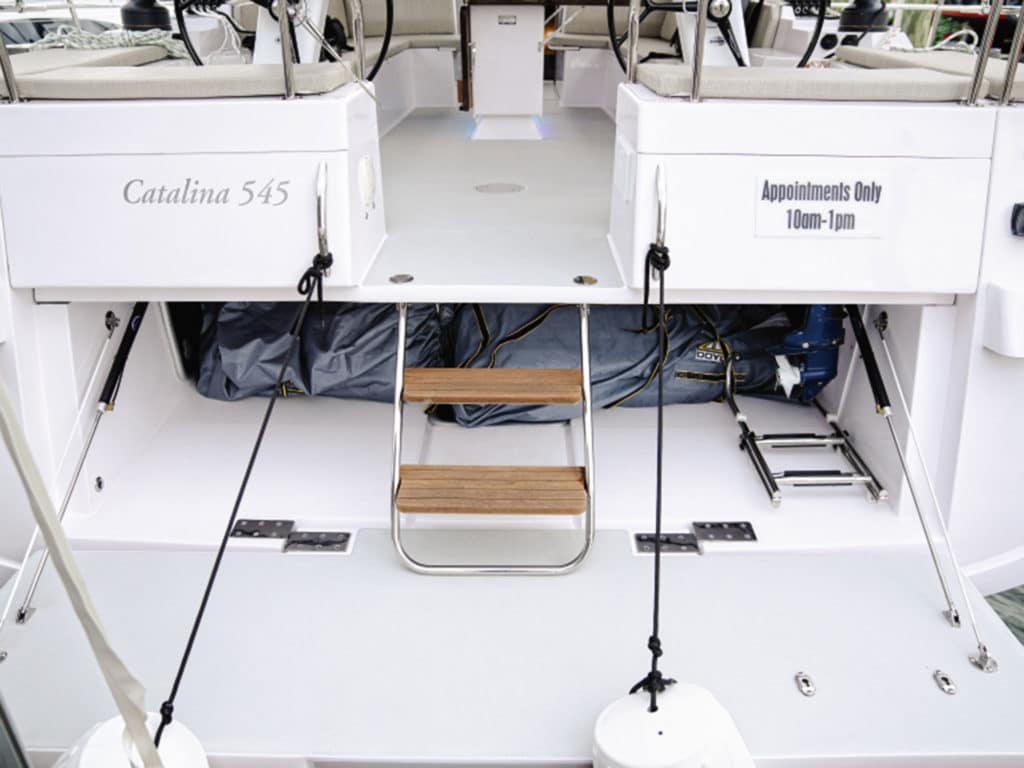
Select the painter wisely. While it would be ideal if it floated, common polypropylene quickly degrades in the sun. Three-strand or braided nylon is strong and durable. Beyond capsize or filling with spray or rainwater, a third risk is having the painter foul the propeller. Years ago, while entering Chesapeake City harbor, we ran aground. Instinctively I threw the transmission into reverse and turned to wave off the boats following us. Minutes later, while looking for alternative places to anchor, I noticed that the dinghy was gone. We expected to find it adrift, but no such luck. Then we saw it, totally submerged half under the boat. Yep, the painter fouled the prop, which yanked it underwater. What an idiot! Worse, the dinghy’s bow eye smacked a prop blade, bending it badly. The lesson? Shorten the painter for tight maneuvers.
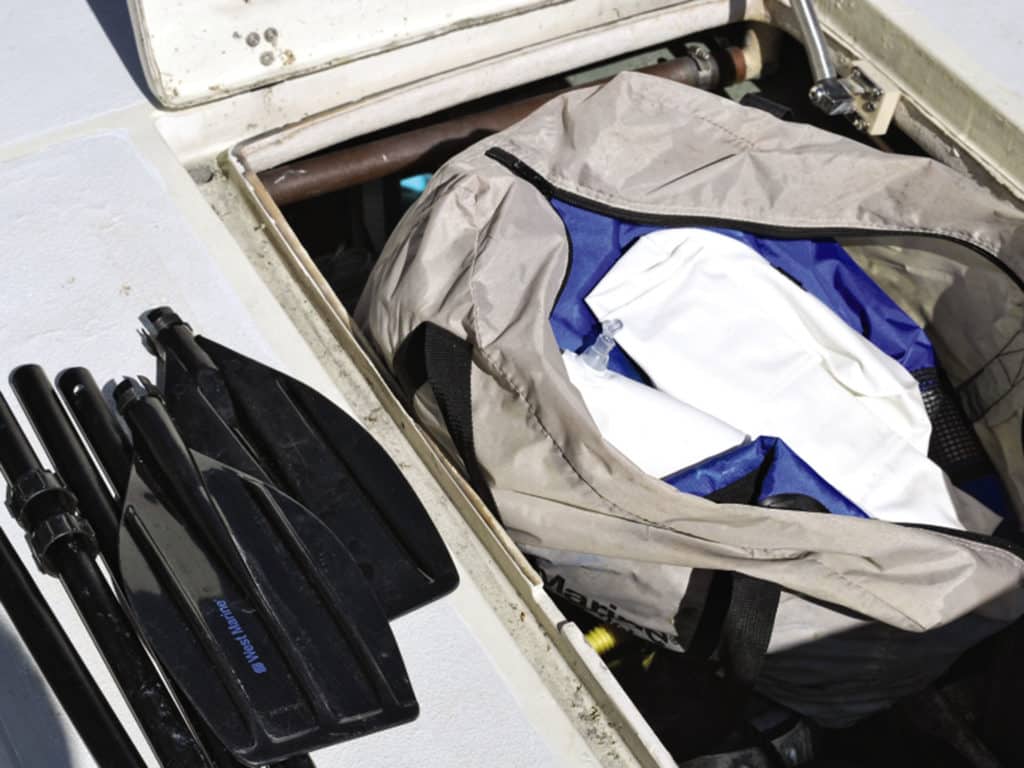
If your tender is inflatable, it might be possible to deflate it to stow in a locker (this rules out RIBs, whose fiberglass or aluminum hulls won’t fit in the lockers of most boats). The one-time commodore of the Ida Lewis Yacht Club in Newport, Rhode Island, to which I once belonged, did this on his Wanderer III replica/sistership.
During one club cruise, upon arrival at an anchorage, I watched from our boat as he retrieved his deflated dinghy from a seat locker, laid it out in the cockpit, and began to inflate it with the familiar foot pump. It took perhaps 10 minutes or so. A 12-volt electric pump would’ve sped up the process. When finished, he tossed it over the side, secured the painter, helped his wife board, and then rowed ashore.
Granted, range in such a dinky dink is severely limited; this skipper eschewed even a small outboard, and inflatables do not row well. But in the right location, it is a means of getting ashore.
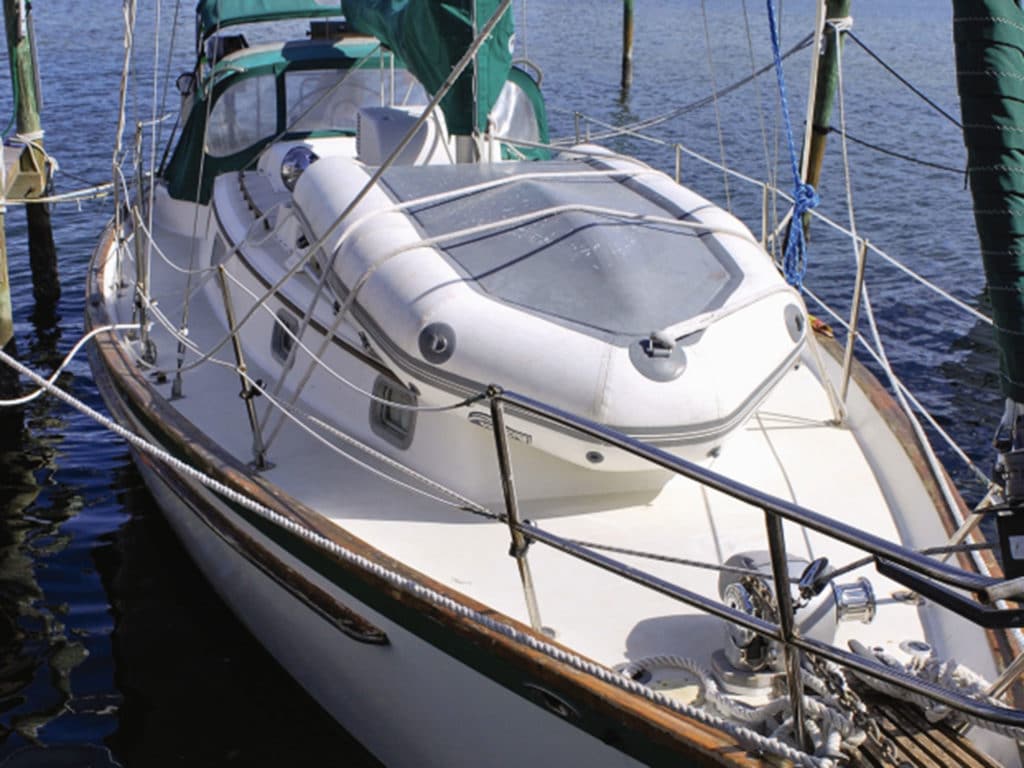
Lashing down a dinghy on deck has long been a go-to option on many cruising boats. It’s dependent on having adequate space available between the mast and cockpit enclosure (dodger or windshield) or between the mast and foredeck. The latter is less preferred, and both require that sail- and boat-handling functions, such as reefing and anchoring, are not compromised.
In this instance, you need to figure out a means of deploying and retrieving the dinghy beyond picking it up with brute strength and flinging it over the side. A four-point bridle with a lift point at the center of gravity enables lifting more or less horizontally. For mechanical advantage, a halyard led to the lift point on one end and to a mast winch at the other will generally get the job done; the main difficulty is pushing the dinghy outboard over the water. A helper on the side deck, perhaps aided by a boat hook, will make the job easier and hopefully avoid a messy situation.
Minutes later, we noticed the dinghy was gone. Yep, the painter fouled the prop, which dragged it underwater.
The dinghy can be secured by multiple wraps of line to handrails port and starboard. Tighten well or use ratchet straps. Oars can be tied in as part of this package, along with an outboard motor set on the familiar rail mount. If it’s too heavy to hand down to a waiting dinghy in the water, consider an outboard-motor lift installed at the stern that employs a block and tackle to safely lower and raise the outboard off and onto its adjacent mount.
Ah, davits. While davit hardware is somewhat expensive, this is a good option for coastal cruising. It is much safer than towing, and compared with lashing on deck, greatly simplifies launching and retrieval. If the boat has a swim platform, as more modern boats now do, it also simplifies getting in and out of the dinghy. Climbing down a transom ladder works too. And it’s usually OK to keep the outboard mounted on the tender’s transom, avoiding the often-tense business of lowering the motor from the deck to the dinghy.
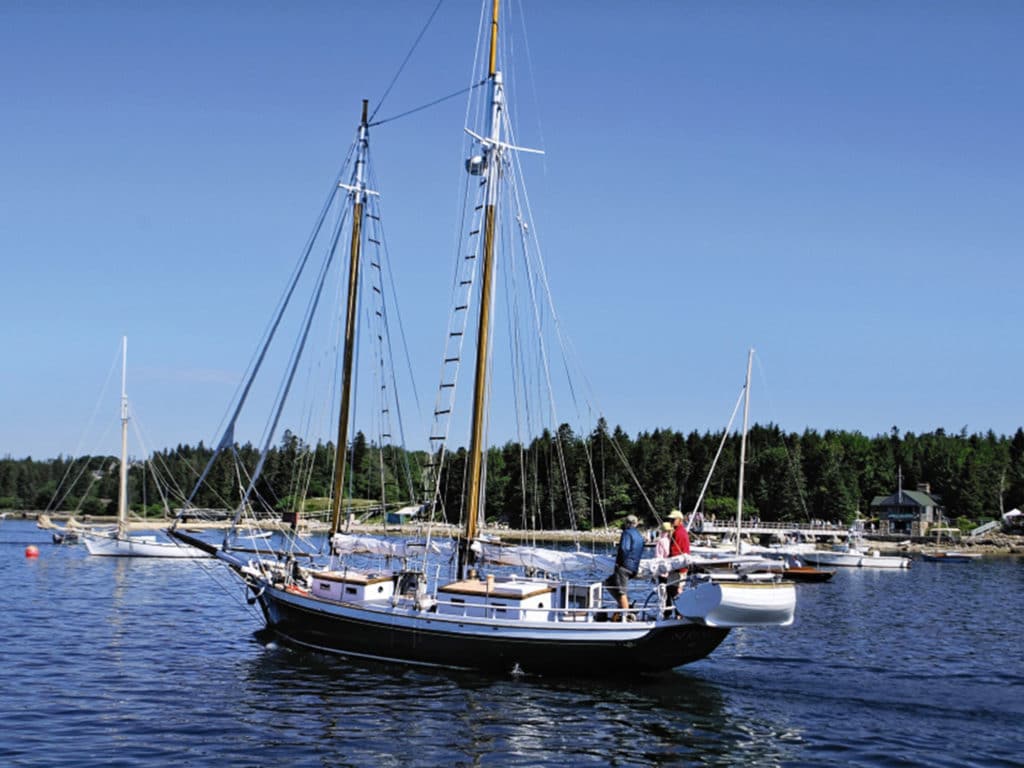
However, large breaking seas could rip off the dinghy and mangle the apparatus, possibly jeopardizing the big boat. And when docking, remember you’ve got baggage back there and don’t want to snag it on something, or bash a piling or other boat.
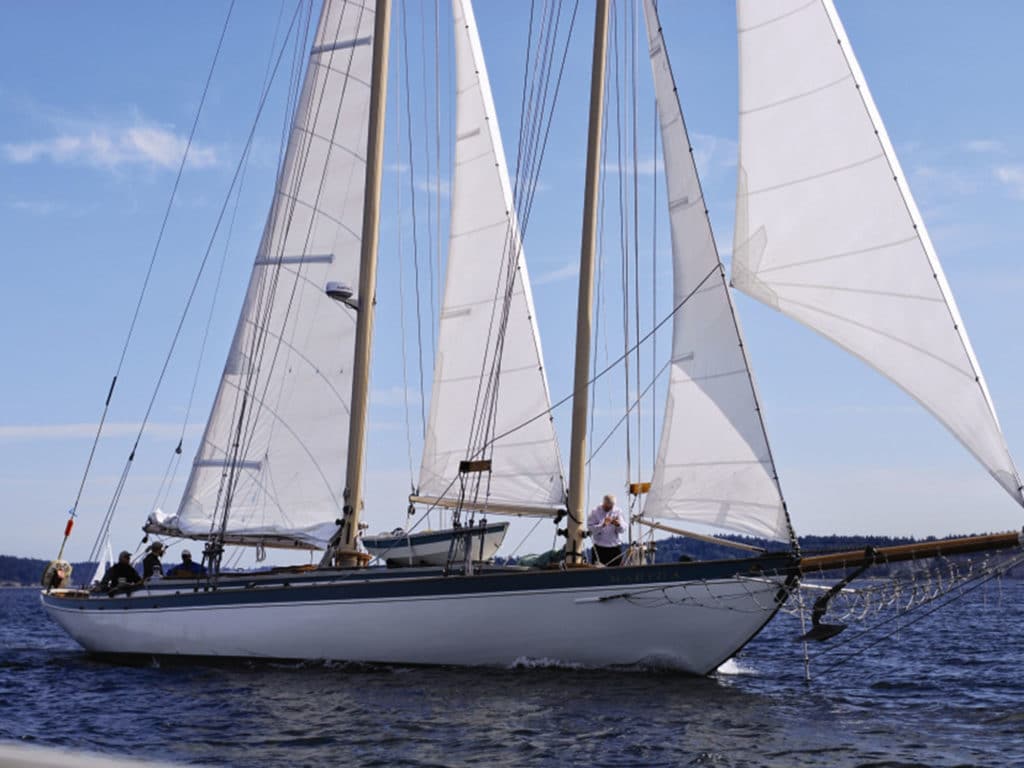
There is variety in the design of sailboat davits; for heavy loads, they mount on the afterdeck or transom, well reinforced below. With loads up to around 350 pounds, there are systems that can be mounted on a sturdy stern rail, and even kits to reinforce the stern rail.
Some large traditional sailboats, such as schooners and windjammers, carry a shore launch in davits above the midship deck, but this won’t be a viable solution for most cruising sailboats.
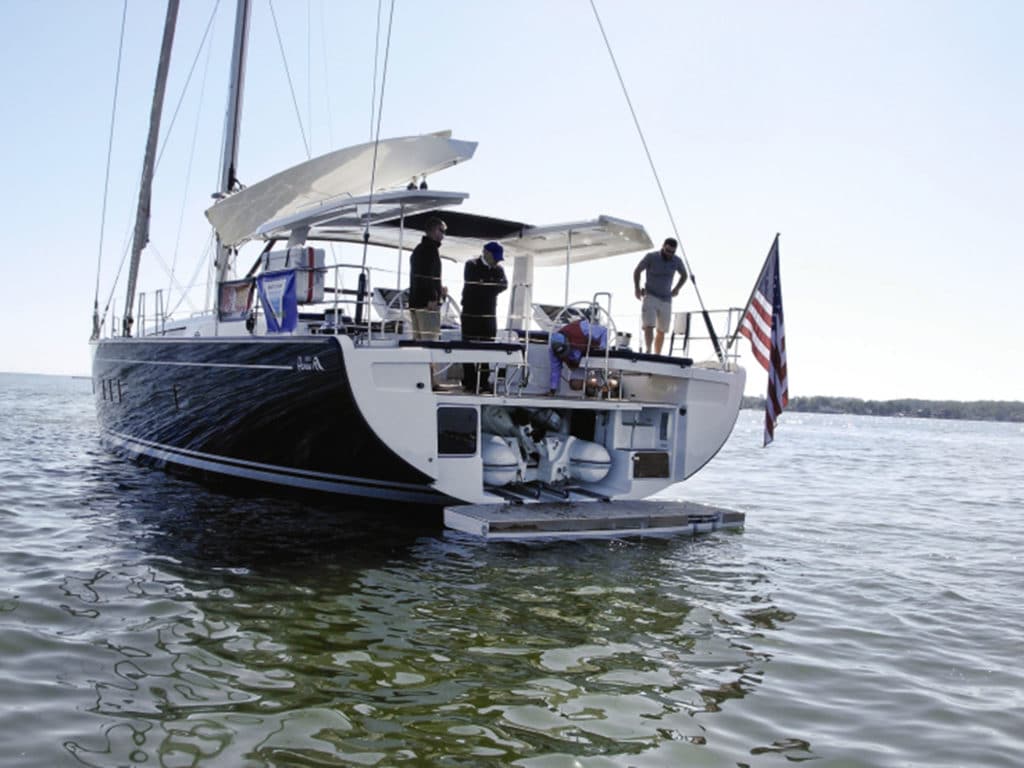
We’re back where we started, with the dinghy garage that was so popular in the 2020 BOTY competition. With so many larger boats carrying max beam aft to the transom, some designers and builders are incorporating the so-called garage for even fairly large RIBs with steering consoles under the cockpit floor, as mentioned. This is probably the safest, most secure way to carry a dinghy. Big boats such as the Hanse 675 and others employed garages with a variety of enclosure systems, most hydraulically activated. Sliding cradles that facilitate launching and retrieval with handheld controllers mean you don’t have to risk slipping a disc trying to grunt the beast aboard. Pretty slick! This isn’t something you could retrofit to an older design, but if you’re in the market for a new boat, it’s a feature well worth investigating.
Yachting journalist Dan Spurr has stowed dinghies on a long line of cruising boats he’s owned, ranging from a 28-foot Pearson Triton to a powerful Tartan 44.
- More: dinghy , How To , print aug sept 2020 , tender
- More How To
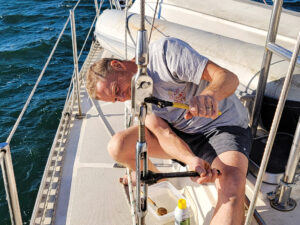
How to Rig Everything in Your Favor
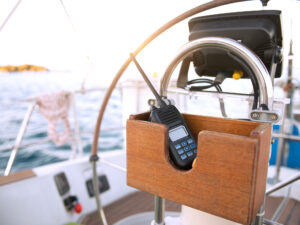
Is There a Doctor Aboard?

3 Clutch Sails For Peak Performance

It’s Time to Rethink Your Ditch Kit

Cruising the Northwest Passage

Balance 442 “Lasai” Set to Debut

A Legendary Sail

10 Best Sailing Movies of All Time
- Digital Edition
- Customer Service
- Privacy Policy
- Email Newsletters
- Cruising World
- Sailing World
- Salt Water Sportsman
- Sport Fishing
- Wakeboarding
- Your cart is currently empty.
Suggested Accessories
Towing your dinghy, inflatable boats: how to tow your dinghy.
In the event that you are unable to stow your inflatable boat onboard your sailboat or powerboat, you may need to tow your inflatable boat . A tow bridle is required to properly tow your inflatable. In this article, we will share the correct method for towing your rubber dinghy.
When towing a Newport Vessels dinghy boat , we recommend a 3-point bridle for the most effective and efficient means of towing. Some inflatable brands cut costs by limiting hardware, if your dinghy only has two bow D-Rings, a 2-point bridle can suffice, but will put more strain on each attachment point.
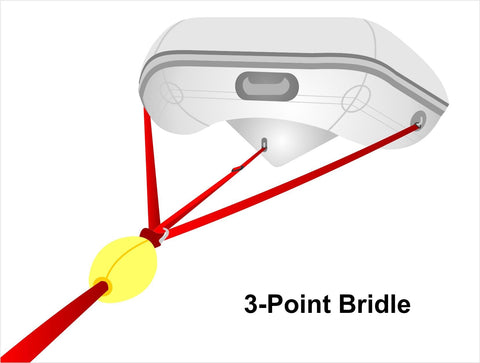
First, secure a tow line to the middle cleat on the stern of the mother ship. Tie a bowline at the end of the tow rope, unless there is already an eye splice. Attach this bowline knot to a ring. Take one part of rope and pass it through the ring at the end of the towline. Create a bowline knot on both ends of the rope and attach them to the D-ring on the starboard and port side of your inflatable. Take one more part of rope and secure it to the middle bow ring. If you do not possess a middle cleat on the mothership, you can follow the same instructions for creating a bridle for your dinghy. If you can only utilize a 2-point bridle, place the connections on the starboard and port side of your rubber dinghy.
The tow line should end in a bowline loop with the bridle passing through. If the towline is fixed to the center of the bridle, it will cause wear on the center pad eye. If the towline has freedom for some movement, both sides of the bridle with have consistent tension allowing the load to be evenly distributed.

Make sure all parts of rope have tension on them for even distribution of weight when being towed. Having one rope with slack will cause greater wear on the other two attachments on your inflatable. Finish off by placing a float on your line to help prevent the potential of the rope getting caught in your propeller. You can also utilize ⅜” polypropylene rope for best results; it naturally floats.
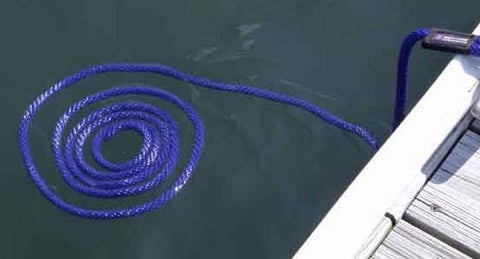
When towing your inflatable behind you, make sure the dinghy is in the V-wake being created by your boat. Having the dinghy placed so it is on the back of the wake created by your wave will put less strain on the bridle and your D-rings. A good rule of thumb is to keep your dinghy two waves behind you at around 8 knots. The faster you go, the farther you will want your dinghy behind you. We do not recommend towing at high speeds as this can cause many issues.
Remove your outboard and other heavy items from inside the inflatable boat before towing the rubber dinghy. Leaving your outboard on the transom while towing can become hazardous. If hit by large waves during towing, your rubber dinghy can flip, submerging the motor, your outboard can fall off the transom and it adds extra weight which strains the tow bridle. If you are unable to remove the outboard motor, tilt your motor up to lessen drag and secure a cable to it in the event the mounting system fails. Also, drive slowly to put less stress on the boat and the tow bridle.
Dinghy Towing Tips:
- Having additional rope is a cheap insurance in case you experience issues.
- Chafing can occur on your inflatable where the bowline knots are attached to the D-rings. Placing the extra patches that came in your repair kit just in front of the D-rings can help reduce damage to your boat.
Join Newport mailing list
Exclusive offers, new products, and members-only content.
- Inflatable Boats
- Trolling Motors
- Electric Outboards
- Accessories
QUICK LINKS
- Boat Registration
- Military Discount
- Warranty Policy
- Warranty Claims
- Shipping & Return Policy
- Terms & Conditions
- Privacy Policy
- Ambassadors
- Ambassador Application
- My Account / Login
- Order Status
- Resource Guides
- Technical Support
- Dealer Application
- Battery Disposal

Service Locator
- Angler Endorsement
- Boat Towing Coverage
- Mechanical Breakdown
- Insurance Requirements in Mexico
- Agreed Hull Value
- Actual Cash Value
- Liability Only
- Insurance Payment Options
- Claims Information
- Towing Service Agreement
- Membership Plans
- Boat Show Tickets
- BoatUS Boats For Sale
- Membership Payment Options
- Consumer Affairs
- Boat Documentation Requirements
- Installation Instructions
- Shipping & Handling Information
- Contact Boat Lettering
- End User Agreement
- Frequently Asked Questions
- Vessel Documentation
- BoatUS Foundation
- Government Affairs
- Powercruisers
- Buying & Selling Advice
- Maintenance
- Tow Vehicles
- Make & Create
- Makeovers & Refitting
- Accessories
- Electronics
- Skills, Tips, Tools
- Spring Preparation
- Winterization
- Boaters’ Rights
- Environment & Clean Water
- Boat Safety
- Navigational Hazards
- Personal Safety
- Batteries & Onboard Power
- Motors, Engines, Propulsion
- Best Day on the Water
- Books & Movies
- Communication & Etiquette
- Contests & Sweepstakes
- Colleges & Tech Schools
- Food, Drink, Entertainment
- New To Boating
- Travel & Destinations
- Watersports
- Anchors & Anchoring
- Boat Handling
- ← Seamanship
Dinghy Basics
Advertisement
Take care of your lifeline to shore to get the most out of it.
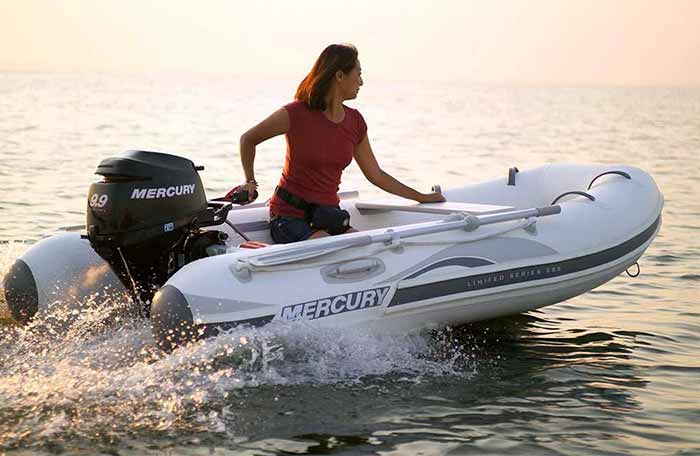
Most boaters prefer inflatables or rigid-bottom inflatables (RIBs), which are often lighter and more stable than hard dinghies and can be deflated for storage or passagemaking. They have the added benefit of being soft, so if you run into anything, like your own big boat, you'll bounce rather than ding. But hard dinghies offer benefits, too. Their keels make them easier to row in a straight line, and you can usually drag them across a beach without damage. Life with a dinghy, whether it's hard or soft, gets easier when you sort out the major issues surrounding the little boats, including towing, guest management, and security.
Tips For Better Dinghy Security
Lock the dinghy and motor while ashore. Ensure that the outboard is secured to the dinghy with a simple lock, with an extended shackle, or, better still, a professional bar lock that covers both outboard screw handles and isn't easy to remove even if someone tries to break the screws. Brass, steel, and Kryptonite bar locks may be purchased at most chandleries.
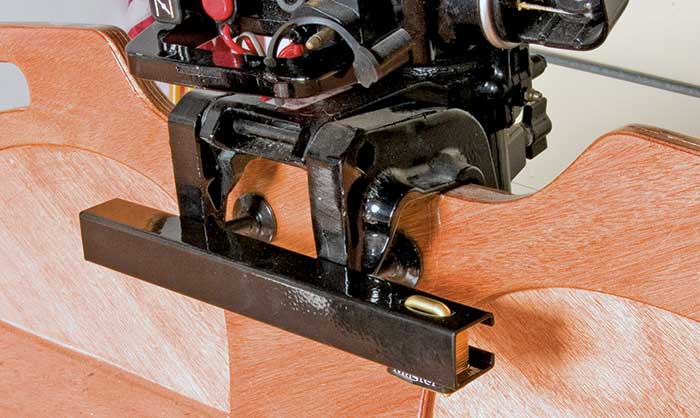
Photo: Mark Corke
Carry a length of cable, with eyes spliced at each end, or chain. Thread this through a hole drilled through the transom, or use some other method to "permanently" attach it to the dinghy. Run it back through an open cleat or some other securing portion of the dock, such as around a beam under the dock. If possible, thread it through the outboard screw handles to secure both boat and engine.
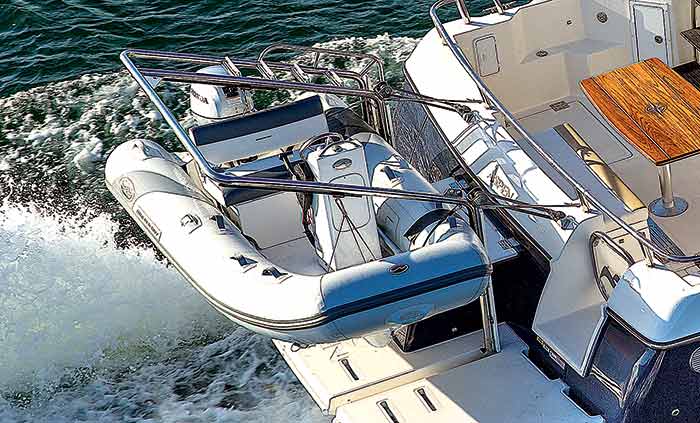
On a boat with davits, always raise the dinghy for the night. On monohull sailboats that don't have davits, lift the dink out of the water with the halyard and tie it to the side at the lifelines. On powerboats, if you must leave it in the water, use a heavy-duty cable and lock to secure the tender and outboard to the mothership. It's safest, though, to hoist the dinghy aboard with a crane or davits. The extra 10 minutes of work at night improves the chances that your dink will still be there in the morning.
Getting Ready To Tow
Much can go wrong when you tow a dinghy. Lines can get fouled, hardware breaks, and the weather may not cooperate. For powerboats with a cradle on the swim platform or, better, a hydraulic platform that lowers below the waterline to scoop up the tender, it's always better to carry the dink. Some motoryachts or sportfishers have a crane to winch the dinghy onto the flybridge or bow; sailboats often have davits, which make quick work of lifting the small boat out of the water. Use them.
For short hops towing the tender, it isn't just about tying the two together and hitting the throttle. First, make sure the tender is empty. Remove paddles, rags, life jackets, and other equipment; store these on the mothership. Shut off and remove the external fuel tank. Check that the plug is installed securely. Under certain circumstances, some boaters prefer to leave the transom plug out on an inflatable. Inflatables don't sink (unless all the chambers pop), and boarding waves or rain can run out that hole in the transom while the mothership is towing. If the plug is left in, the dinghy can fill with water.
Next, remove the outboard. A 60-pound outboard adds too much drag and increases stress to the dinghy transom, tow line, and attachment points. It will slow your progress significantly. If you can't remove the engine, tilt it up and secure it so the lower unit is out of the water. Go SLOWLY.
Your towing bridle, hardware, and line are key. For very short distances, and with a hard dinghy that tracks well and has a padeye on the stem at least 6 inches below the gunwale so the bow rides high, you may be able to get away with attaching a single line directly between the tow and the big boat. For all other tows, especially with an inflatable, rig a bridle. ( See Figure 1. )
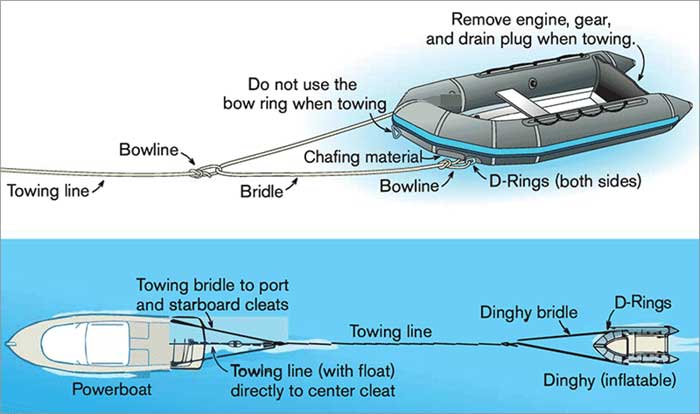
Figure 1: How To Rig A Bridle For A Safe Tow (Illustration: ©2016 Mirto Art Studios)
The inflatable dinghy should have two glued or welded on stainless-steel D-rings on either side of the bow. Connect the ends of a line to each of the rings so you form a triangle that clears the bow by a few feet. Make sure to first pass this bridle through a bowline on the end of the towing line itself so the bridle can slide side-to-side and keep the weight better distributed between the rings. Now, attach the bridle to deck cleats. Slip a float on each end to keep the bridles out of the water, especially near the big boat's prop.
Bridles to D-rings chafe as they rub against the inflatable's fabric, even if the rings are positioned so that each line is clear of the fabric. Wind abeam can cause the dinghy to ride to the side, and wave action does the same, causing the dinghy to jump about, so rig good chafing gear on the port and starboard bows of the inflatable where line may make contact. You can glue spare cloth from inflatable repair kits in this area. It may also be necessary to secure very soft chafing gear to the actual bridle lines. Two bridles often aren't necessary if there's a cleat located in the middle of the stern on the mothership.
For light dinghies, use at least a 3/8-inch floating line, such as polypropylene, or you can use Spectra or Dynema webbing. In case you forget the tow and back up, a floating line should lessen the risk of wrapping the prop. Though, even with this precaution, prop wash may suck the line down.
To help the dinghy track better, attach the bridle as far down on the bow as possible, although this may be limited by the position of the D-rings. Sometimes a dinghy being towed will overtake the mothership as it surfs down a following sea, particularly in a strong following wind. This can cause sharp jerking on the tow line, collisions with the mothership (a serious problem with hard dinghies), the sinking of the dinghy, or situations in which the tow line passes under the mothership, possibly to snag in the rudder or in the prop(s). ( See Figure 2.)
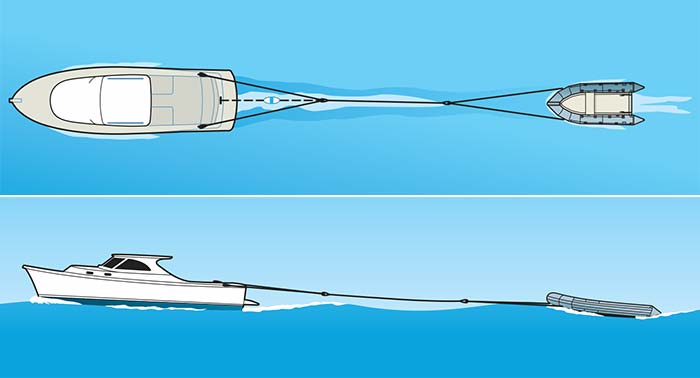
Figure 2: Tow At The Center Of Mothership's Wake. The big and little boats should be in sync, riding the crests and troughs of waves at the same time. In open water, longer lines will create a catenary to lessen shocks when the two boats come out of sync. (Illustration: ©2016 Mirto Art Studios)
5 Basics For Guest In Dinghies
1. loading and unloading.
Don't assume everyone knows how to get in and out of a dinghy. You may be carrying children, older folks, or people who've just never done it. First, secure the dinghy painter to the mothership. Next, when people are boarding, stress the importance of stepping down all the way into the floor of the dinghy, toward the middle, and sitting pronto; don't have them step on the inflatable tubes or on the gunwales of a rigid dink. Everyone's center of gravity should be kept low from the second they board; keep people seated underway.
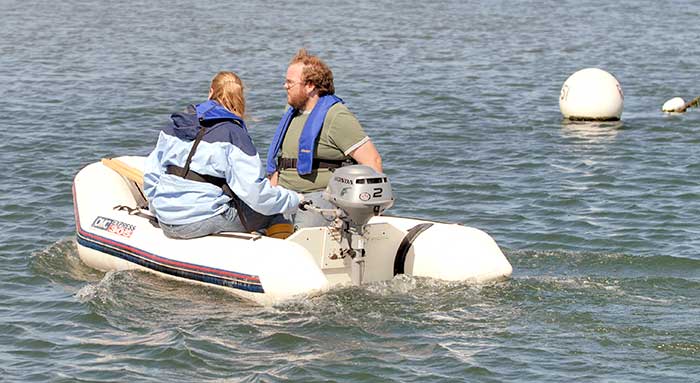
2. Beach Landings
If beach landings are the only way to come ashore, explain beforehand what will happen. Time your ride to surf in with a wave, and pull the motor up before it grounds. Have your strongest passenger jump out first and pull the dink into shallow water, then everyone can hop out, grab a handhold, and pull the dinghy onto the beach quickly. Proper water footwear with straps is important.

3. Night Moves
Finding your boat in the dark can be a challenge. Ask everyone to keep the flashlights off to preserve your night vision until you get near the boat and are ready to tie up and unload. A solar garden light tied to a stanchion provides an inexpensive nighttime marker low on the mothership at the height where people in a dinghy are usually looking. Also, battery-powered LED lights in various colors, such as blue, can be suspended from dodgers or towers and won't drain your onboard energy reserves. Make sure lights such as these don't conflict with lighting required by the Navigation Rules.
4. Nav Lights
Most tenders require only a 360-degree white transom light when running at night. If your dinghy exceeds a speed of 7 knots or is more than 23 feet long, you’ll need red and green bow lights along with a white stern light.
5. Davit Dilemma
Although dealing with davits may be second nature to you, for guests, it's all new. If you ask others to help you raise or power the tender, caution them to keep fingers and long hair away from any blocks or pinch points that could cause injury. Wrap davit lines around a winch or cleat to help hold the dinghy's weight. Dinghies, especially with outboards, are heavy, and too often guests lose control of the line and drop the boat abruptly. Advise that both ends should be raised or lowered evenly and that the drain plug needs to be in before the boat goes in the water. It also must be taken out after the boat is up. If the boat were to fill with rain, the weight could be far too much for the davits. If the big boat has its exhaust aft above the waterline, turn the engine off before lowering the dink and filling it with hot water. Stress the importance of loosely tying the painter to the mothership before unclipping the davit lines.
Ready For Arrival
Just before you arrive at the harbor, marina, or anchorage, pull the dinghy in close before conducting any backing or docking maneuvers. First, bring the mothership to a slow stop, lessening the strain on the line and protecting your hands. Then hand-over-hand the tow line into the boat. It's a good idea to wrap the line around a winch or cleat to lessen the strain on your hands. Bring the tender up close — on the transom, if you're going into a two-finger slip, or up on the hip of the mothership, if you're anchoring or side-tying. Tie it on a short tether.
It's usually best to tie it bow and stern to the hip of the mothership to maintain better control. Towing through a harbor should never involve a long line like what you'd use in open water; it creates a hazard for other boats as well as for your tender.
Towing a dinghy is not a "set it and forget it" procedure. Make sure to look back regularly to check on it, especially if the wind picks up or sea state deteriorates. If the dink ships water from waves or rain, it will increase drag quickly. A 4-foot by 8-foot dinghy with only a few inches of water covering the bottom translates to hundreds of pounds of weight/drag/stress on dinghy D-rings, slow progress, and fuel inefficiency. It's also possible for a dinghy to flip over and submerge the motor or engine or even break loose, so keep a watchful eye on your tow at all times.
Finally, consider your towing speed. Don't tow a dinghy so quickly that it becomes airborne. Never tow in questionable conditions. If you absolutely must tow, start slow. Powerboaters may be tempted to get a planing hull up to speed; this will put extra pressure on every piece of this puzzle. Don't do it. Never tow a dinghy on long passages.
Critical Equipment And Advice
Never overload your dinghy, or you'll swamp it. Check your dinghy's capacity plate, and stay below the weight limit.
Put together a bag of essentials to take with you in the dinghy. An open-mesh bag works, and it can be secured under the middle seat with bungees, where it's easily accessed but not underfoot. Include:
- Bailer to offload rainwater or seepage from a slow leak. A cut-off plastic bleach or gallon water bottle with the lid screwed on works and provides a built-in handle.
- Hand pump for ejecting more water more quickly
- Mirror to signal for help in an emergency
- Extra drain plug
- Spare outboard key
- Baseball cap, sunscreen, and spare drinking water
- Life jackets for the number of people using the dinghy. Add extras for guests and properly sized ones for kids, and wear them.
Everyone in the dinghy should be wearing a life jacket while the boat is underway. Many dinghies move at a fast clip, and guests especially are vulnerable to falling overboard.
Every dinghy needs to be equipped with paddles, which are essential backup.
It's a good idea to bring the following, because even a short trip to a nearby boat can go wrong if the motor dies and the tide and/or wind sweeps you away:
- Waterproof flashlight, in case you return in the dark or need to read your combination lock. Check these batteries at least once a month.
- VHF and/or a cellphone, all in a drybag
- Extra set of boat keys
- Personal location beacon
- Extra length of line to extend the painter and tie to a tree or rock ashore.
- Two rags: one for wiping down, one for keeping gas spills contained when refilling the outboard.
Related Articles
The truth about ceramic coatings for boats.
Our editor investigates the marketing claims of consumer-grade ceramic coatings.
Fine-Tune Your Side Scan Fishfinder
Take your side-scanning fishfinder off auto mode, and you’ll be spotting your prey from afar in no time
DIY Boat Foam Decking
Closed-cell foam flooring helps make boating more comfortable. Here’s how to install it on your vessel
Click to explore related articles
Zuzana Prochazka
Contributor, BoatUS Magazine
Zuzana Prochazka is a freelance journalist specializing in writing, editing, and photography in boating and travel publications. She writes for a dozen boating magazines and websites and a growing list of travel publications. She enjoys combining her passions, which include seeing the world, sailing the oceans, and sharing her experiences through the written word. She holds a U.S. Coast Guard 100 Master license.
BoatUS Magazine Is A Benefit Of BoatUS Membership
Membership Benefits Include:
Subscription to the print version of BoatUS Magazine
4% back on purchases from West Marine stores or online at WestMarine.com
Discounts on fuel, transient slips, repairs and more at over 1,200 businesses
Deals on cruises, charters, car rentals, hotel stays and more…
All for only $25/year!
We use cookies to enhance your visit to our website and to improve your experience. By continuing to use our website, you’re agreeing to our cookie policy.
- Skip to primary navigation
- Skip to main content
- Skip to primary sidebar
- Skip to footer
Yacht Cruising Lifestyle
Everything fun you can do from your yacht
Choosing the Best Dinghy for Your Boat
January 7, 2021 by Travis Turgeon 5 Comments
At anchor, a dinghy boat serves as your lifeline to everything from leisurely excursions to provisioning trips. Every captain or crew will use their dinghy differently, so it’s essential to consider what features and functions are important to you.
Do you plan to explore remote areas away from anchor? Do you plan to fish, snorkel, or dive from the dinghy? How many people will you need to carry at once? Every aspect should play into your decision.
Below, we cover the following to help you choose a dinghy that’s right for your boat:
- Key Factors to Consider
- Types of Dinghies
- Outboard Motors
General Information and Tips
What should i consider before buying a dinghy for my boat.
Make the following considerations before purchasing a dinghy for your boat:
- DInghy Storage
- Carrying Capacity
- Use of the Vessel
Dinghy Storage
Storage should be a defining factor when purchasing a dinghy for your boat. There are several common ways to store a dinghy, but not all storage is suitable for every vessel. A rigid dinghy will need enough space to be tied on the deck or at the back of the boat, while you can stow an inflatable dinghy in lockers or lazarettes.
Regardless of where you choose to keep your dinghy on the boat, it should be in a location that does not reduce drag, restrict access to important areas, or prevent easy access for storage and use.
The most common options are:
- Dinghy Davits
- On-Deck
- Locker
Davits: Permanently installed at the stern of the boat, davits are used to store, deploy, and retrieve your dinghy from the water. Davit storage is standard for any dinghy that’s too heavy to manually lift in and out of the water. Although storage on dinghy davits is convenient, it poses a risk when sailing through heavy seas. Large waves and wind can cause the dinghy to flood while in transit, and the weight can damage the stern of the boat or the davits.
On-Deck: Some people choose to tie the dinghy upside-down at the bow, stern, or side of the boat. For this to be an option, you need sufficient unused space on the deck, and you need to be sure that the dinghy is not interfering with any important pathway or area on the boat.
Swim-Step: Boats with an elevated swim-step can accommodate a dinghy at the boat’s stern as long as it’s elevated far enough out of the water. Keep the dinghy tied aerodynamically and tilted so that it doesn’t fill with water.
Locker: Roll-up inflatable dinghies are easily deployed and retrieved from the water by hand, and they can be deflated and stored in a locker anywhere onboard.
Towed: For nearshore journeys in calm conditions, you can easily pull the dinghy behind your boat. Be careful, though, as high speeds and choppy seas can cause a dinghy to flip in the water.
Dinghy Carrying Capacity
If you’re sailing with multiple crew or passengers, you will want a dinghy that can carry the same amount of people. Making numerous trips from ship to shore will not only cost you time, but it will also run up fuel costs. Further, you’ll want extra room for luggage, provisions, recreational gear, and anything else that may find its way onto your boat.
The handling in your dinghy can become problematic when loaded beyond capacity, so use caution – especially in rough seas. Safety should always be a top priority, so the goal is to aim for the biggest dinghy you can get without sacrificing too much storage space.
Dinghy Material
Rigid dinghies are most commonly made of fiberglass or aluminum, but you can opt for a more classic wooden design as well. The material will partially dictate where the dinghy can be stored and the need for equipment such as dinghy davits. While fiberglass hulls are cheaper than aluminum, they also come with the burden of a heavier weight. Alternatively, aluminum hulls will outlast their fiberglass counterparts, but for a higher price. Overall, rigid dinghies can withstand wear-and-tear better than inflatables, although routine maintenance is required.
Inflatable dinghies are kept afloat using tubes surrounding the boat’s hull, commonly made of either PVC or CSE. CSE, or “Hypalon,” is a synthetic rubber material that is highly resistant to chemicals, UV light, extreme temperatures, and abrasion. CSE is a lot like PVC, but it’s lighter and has more UV and water-resistant properties. It’s also more abrasion resistant, making it ideal for taking to shore. CSE offers a longer service life and a more extended warranty, although again at a higher cost. The most common complaint you’ll hear about CSE is the rate at which the air escapes from the tubes. On average, CSE tubes lose about 15% of their air within 24 hours, while PVC loses under 7%.
PVC is an excellent alternative to the more durable CSE, as the material still offers a reasonable service life at a lower cost. PVC is also much lighter, more convenient to fold, and easier to clean than CSE. The biggest potential problem with PVC is simple neglect and lack of maintenance. If cared for properly, modern PVC materials can last long enough to justify not paying the higher costs for CSE.
For some excellent tips on maintaining your inflatable dinghy, check out Sail Magazine’s Tender Choices article , here.
How You’ll Use The Dinghy
The last factor to consider is how you intend to use the vessel. Will you be traveling long distances from anchor? Exploring remote locations? How many people do you need to transport? Do you need special features to accommodate scuba diving and fishing? You should do as much research as you can to ensure that you’re buying a tender that suits your needs while staying within your budget. Below, we discuss the difference between each type of dinghy – and who each is best suited for.
Types of Dinghies
Choosing the right type of dinghy for you and your boat will require some careful thought. Your dinghy is your primary source of transportation between journeys, and you’ll want to make sure that your purchase is fitting for your immediate and future needs.
The three most common types of dinghies are:
Rigid Boats
Inflatable boats, rigid inflatable boats (rib).
Hard-body (rigid) dinghies are among the simplest styles of tender, and they come in a variety of shapes, sizes, and materials. Rigid dinghies are sufficient for those who don’t need to travel long distances or through rough conditions. However, more and more people are moving to inflatables or semi-inflatables for their wide range of abilities when needed.
When considering if a rigid dinghy is right for you, think hard about the material each is built with. For the hull specifically, the materials will affect the price, durability, and cosmetics of the vessel, as well as the weight and ability to transport. Most rigid dinghies are constructed with fiberglass, aluminum, or wood and have a lower carrying capacity than inflatables. They also have less stability when entering, exiting, and moving through the water.
Advantages:
- Easily Propelled
- Puncture Resistant
- Outboard Compatible
- Low-Cost Option
- UV Resistant
Disadvantages:
- Easily Scratched and Blemished
- Adequate Storage Space Required
More popular than rigid dinghies and less popular than RIB’s, inflatables offer a good middle ground for those looking to compromise between cost and functionality. The large PVC or Polyurethane tubes in the front and sides of the boat are more stable than rigid vessels and allow for a higher carrying capacity due to their buoyancy. Compare those benefits with the low costs of materials, and it’s easy to see why inflatables are so popular.
There are numerous variations of Inflatable dinghies, with the most common being:
- Soft Bottom Roll-Up
- Rigid Floor with Soft Bottom
- Soft Bottom with Rigid Transom
Dinghies with soft bottom have the widest variance in configuration. Some have rigid transoms where an outboard motor can be mounted. Some have rigid, removable floors, and some have an inflatable keel that increases the vessel’s stability and planing abilities. Other than the lower-end inflatables, though, almost all will have stable floors and a captain’s seat. Rowing is difficult in rough conditions, so inflatables are most commonly used with a 5-10 horsepower outboard.
Roll-up inflatables are easily stored, don’t take up much space, and are the lightest of all inflatable options. They also have the least to offer in functionality, and since most don’t have a rigid transom, they must be rowed by hand. Unless you only plan to use the vessel in calm conditions, you should consider dinghies with hard floors and transoms.
Soft bottom dinghies with rigid floors and transoms are more ideal, as they can be used efficiently in a wider variety of situations. The ability to mount an outboard allows you to use the vessel in harsher conditions and travel greater distances. The rigid floors allow you to use the vessel for fishing, diving, provisioning, and more without sacrificing stability and comfort.
- Lightest Option
- Easily Compacted and Stored
- Easily Damaged and Punctured
- Consistent Maintenance Required
- Low Efficiency
The RIB design is a cross between a soft bottom and rigid hull and gives you the most bang for your buck in the water. The hard-bodied hull makes for a stable and damage-resistant body, while the inflatable tubes add optimal stability. The RIB design is so efficient that it’s even used by the US Military and Coast Guard. The tradeoff you make with a RIB is portability and storage, as the hull can not be taken apart or broken down. However, this can be overlooked by carefully choosing a RIB that’s right for your boat. If you’re looking to outfit your boat for scuba diving , a RIB should be pretty much your only consideration for a tender.
Rigid Inflatable Dinghies are the most popular type of dinghy for cruising sailors, and it’s easy to see why. RIBs used as dinghies are commonly between 10 and 15-feet long, with anything larger being reserved for massive yachts with dinghy garages or excess storage space. RIBs are typically stored on davits or lashed upside down somewhere on the deck of the boat. For shorter trips near shore and in calm conditions, you can tow the RIB behind the boat.
Typically, RIBs are available with either aluminum or fiberglass hulls. Aluminum is lighter and stronger than fiberglass, although you should expect to see a price tag that matches those benefits.
- Optimal Speed, Handling, and Stability Rugged
- Limited Storage Options
Outboard Dinghy Motors
After choosing the dinghy that’s right for you and your vessel, you’ll need to select an outboard to fit. You’ll want something powerful enough to make the dinghy plane at full capacity but also light enough to transfer to and from the dinghy‘s transom. Before making a decision, check with the manufacturer to determine the recommended power output for your intended use.
Generally speaking, fully inflatable dinghies that measure around 10-feet in length support a 5-8 horsepower outboard, which is sufficient for the basics. For a more capable inflatable, look for a 10-25 horsepower outboard. Just be cautious, as too much power can flip a lightweight dinghy.
Similarly, a 10-foot RIB will support a heavier engine, such as a 10-15 horsepower outboard that provides enough power for the boat to plane while carrying more than one passenger. For more capability, look for an outboard in the 20-50 horsepower range.
Either way, you’ll need to decide your dinghy’s primary purpose and buy an outboard to support it.
If it’s simply used for trips to shore in calm conditions, a lower-powered outboard will likely be sufficient. The more power you can apply, the more capable your dinghy will become. Further, the maximum power output of the engine should always exceed the recommendations for operating the dinghy at full capacity. If you have a powerful outboard, you won’t have to worry as much about overworking the engine when the boat is full.
When determining which motor is right for you, keep in mind the storage and transportation options you have. If you need to lift the dinghy and outboard out of the water manually, it might be safe to say that the lighter the outboard’s weight, the better. If your back can handle the extra weight, though, the 4-stroke engines are far better suited for things like water sports and rough surface conditions.
Dinghy Excursion Checklist
- Check inflation levels and make sure there is no water inside the boat. If there is, look for leaks or damage.
- Ensure the boat is free of all loose lines, flags, or anything that could get caught in the boat propeller.
- Check to make sure the outboard is appropriately and securely mounted to the transom.
- Quickly test both the forward and reverse gears to make sure everything is working as it should.
- Test the lights on the dinghy, even if it’s still light out.
- Check for paddles, lifejackets, first-aid kits, and dinghy repair kits.
Operating the Dinghy
- When operating the dinghy alone, clip the emergency motor stop to your clothing. If you fall overboard, your motor will stop.
- Be cautious when using a powerful outboard. Too much power can cause a lightweight inflatable to flip or overturn.
- Bring the dinghy upwind when returning to your boat for a more controlled approach.
- Always use both front and rear-facing lights when operating the dinghy after dark.
- When towing the dinghy behind your boat, experiment with the length of the tow rope to find the smoothest pull.
- If there is any surf present, do not attempt to beach your dinghy.
- Use a dinghy anchor if there are large tide changes, waves, or swells present.
- Keep a dinghy repair kit on board at all times in case of small punctures or tears.
- Dinghy covers reduce UV light exposure and prolong the life of the dinghy by up to five years.
- Cosmetically, CSE doesn’t wear down for about 10 years. PVC begins to look rough after only a few.
- Consider where you intend to use your dinghy. Will it be in locations with high swells, rocky shores, and cold water? If so, consider a more rugged and damage-resistant material.
- Before purchasing a dinghy, visit a few boat shows, and read user reviews. You want to be comfortable making a purchase, and having first-hand resources to chat with is the best way to feel confident about your decision.
- Keep your dinghy insured separately in case of incidents that happen away from your yacht.
- Dinghies and their outboard motors are common targets of theft, so be sure to lock up both whenever possible.
When choosing a dinghy for your cruising lifestyle, it’s important to know exactly how to buy a new or used boat and what considerations should be prioritized.
Join the #BoatLife community and contribute to our new forum! Get a new conversation started, or use your experience to address existing posts.
If you found this article helpful, please leave a comment below, share it on social media, and subscribe to our email list.
For direct questions and comments, shoot me an email at [email protected]
Sharing is caring!
Reader Interactions
July 3, 2021 at 10:26 am
I have one for my canoe, my dinghy, and my power boat So, the next time you see a 5 year old boat in Seabridge marina in Ventura California, that looks brand new, it’s my boat.
July 30, 2021 at 8:17 am
It is a great article and quite intresting to read too thanks for sharing such good information with us.
August 1, 2021 at 4:15 pm
Thanks for reading, Cassey. We’re always here to help – don’t hesitate to reach out with any questions or comments!
December 14, 2021 at 2:08 pm
Travis – My name is Mark and I am a member of the Great Lakes Cruising Club. We’ve been around since 1934, we have 2,500 US & Canadian members and we are a volunteer driven organization. For the last twelve years we have operated an on-line school, the GLCCSchool.com. Annually we present 35-40 webinars and have an attendance of around 900 people. We really liked your article on dinghies and are wondering if you would consider turning that into a presentation for our school. If you have the slightest interest please check us out and send me an email so we can explore this further. Thanks.
January 23, 2022 at 2:27 pm
Thank you for all of the applicable information. I appreciate how the differences of each type of boat were well defined. This article was extremely helpful.
Leave a Reply Cancel reply
Your email address will not be published. Required fields are marked *
Save my name, email, and website in this browser for the next time I comment.
MB #20512 PO BOX 480 Sevenoaks Kent TN13 9JY
Tel: +44 56 0386 9163
Keep In Touch
Thank you for reading.
Join our online crew and find more about the #boatlife
- Paddle Board

A Guide to Dinghy Boats
Are you looking for an affordable boat for your fishing trips or watersports? The dinghy offers you the best options for a low-cost, versatile watercraft. There are several dinghy designs to suit any watersports activity.
Typically, dinghies are the best choice for watersports like skiing and diving. However, some models are good for cruising or light sailing, with options for motors or sails. A dinghy can range in size, but most of them are suitable for carrying two to six people.
Dinghies are available in models suiting use in freshwater or saltwater, with inflatables, solid boats, and more options. Is a dinghy the right choice for your boat? Let’s unpack everything you need to know about these watercraft.
What Is a Dinghy Boat?
A dinghy is a small boat, usually and inflatable, and most models are around five to ten feet long. A dinghy is easy to transport, and it offers versatile utility for fishing and watersports. You also have options for motors, sales, or you can use oars to propel the boat.
Dinghies can feature fiberglass construction, or they may use inflatable pontoons, similar to a pontoon boat. The inflatable models typically feature design and construction with Hypalon or PVC. These polymers provide UV resistance, tough resistance against punctures, and easy repairs.
The sides on inflatables also act as seats, allowing fishing directly from all sides of the boat. Dinghies are not really built for speed; they usually come with low-powered trolling motors with a 3-hp to 5-hp output. However, they are ideal for moving through estuaries and lakes, allowing for silent movement so you don’t disturb the fish.
What are the best beginner sailing dinghies?
If you’re just getting into sailing, there are several dinghy options for enjoying your time out on the water. Whether you want to sail solo or with a friend, there is a boat for you.
Training Sailing Dinghies
These models are easy to master, giving beginners the chance to master the complexities of sailboats. They are simple to operate, safe, and offer you the best option for learning to master sailing techniques.
Doublehanded Sailing Dinghies
These models cater to two passengers for handling the sail and rigging. They are great for learners, allowing them to take an experienced sailor out on the water to learn the ropes.
Singlehanded Sailing Dinghies
These models have a design for one person. Typically, they are smaller boats, and you’ll already have to know how to sail. However, they are easy to master, and spending time out on the water will familiarize you with the aspects of sailboats.
These dinghies feature double or triple hulls. They are typically the best choice for racing, and they offer excellent stability in all water conditions.
Different Types of Dinghy Models
As mentioned, there are several models of dinghies for different watersports activities. Here are the most common options; we categorized them into sailing dinghies and inflatable dinghies.
Sailing Dinghies
A sailing dinghy is a small sailboat with no fixed keel and a shallow draft. These models are ideal for sailing in lagoons, estuaries, and lakes, navigating shallow waters. The sailing dinghy typically features a fiberglass design, with an open-plan seating area and a mast. These boats usually accommodate anywhere from one to five passengers.

High-Performance Dinghies
High-performance sailing dinghies are another sail-based model that’s ideal for racing. They are fast and cut through the water with ease. You get excellent maneuverability on the water with a low-profile design and an open-plan deck with a mast. The Fireball, International 505, and Thistle are a few examples of leading racing and high-performance dinghies.
Cruising Dinghies
A cruising dinghy is another sail-based model that’s a great choice for cruising out in calm ocean conditions or inland water bodies. They are a recreational vessel equipped with sails and rudders, and you have more passenger capacity than the other sailing models. As a result, they are the ideal choice for family’s that enjoy the sailing lifestyle.
Cruiser-Racer Dinghies
These models are hybrids that come with a focus on performance and stability. They have the ability to race or to cruise, providing excellent stability in the water. They are a great choice for someone that wants to start sailing competitively, and they also work for fun recreational sailing days on the lake with the family. The GP14 is an example of a cruiser-racer offering high-performance standards and stable cruising.
Classic Dinghies
These boats had an original design featuring wood finishes using materials like plywood and cedar. However, modern dinghies feature fiberglass construction. The classic dinghy sailboat focuses on versatility over sailing performance. The Minto is a great example of a classic dinghy.
Inflatable Dinghies
Inflatables are gaining in popularity thanks to the affordable price tag and versatility offered by the boat. Inflatables are easy to carry, and some might even fit on the back of a truck. Inflatables have side pontoons, and many of them are suitable for diving activities or spearfishing. These dinghies usually feature low-powered trolling motors; they don’t have a design for speed.
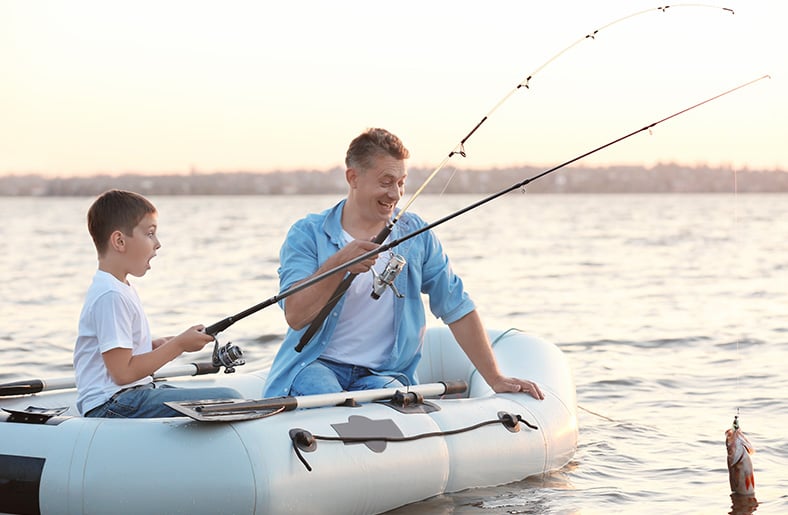
Features and Benefits of Dinghy Boat
Dinghies are versatile and affordable. There are plenty of benefits for choosing this boat beyond just the savings you make over other models.
The dinghy is one of the few boats left that offer a sailing configuration. If you’re into boating on lakes or thinking about sailing competitively, the dinghy is the best choice. Any of the sailing models listed above are a great choice. Pick the boat that offers you the best utility for your sailing needs.
Minimal Noise
Most dinghies are sailing options, so you don’t have to worry about gas fumes from the motor or noise. They offer a serene sailing experience on inland waters. Inflatable models may use a trolling engine for moving through calm, shallow waters when fishing. The low noise and churn produced by the motors won’t scare off the fish. You also have options for poling and oars for moving around without engines.
Trailerable
Dinghies are compact boats with sailing and inflatable models offering you easy trailering. Some of the smaller inflatables can fit in the back of a panel van or on the load bed of your single-cab truck. They offer you easy transport between lakes and estuaries, with a lightweight design that’s easy to launch and trailer.
Options for Inflatables or Fiberglass
As mentioned, the dinghy comes in sailing and inflatable options. Some fiberglass models also feature a wood finish on the deck for an added aesthetic that looks like a classic dinghy.
Ideal as an Excursion Boat for Yachts
Many superyachts use inflatable dinghies allowing the passengers to reach the shore. Yachts can’t enter shallow water, and the dinghy makes the ideal transfer boat for reaching the coast from open water. Most of these models feature low-powered motors.
No Need for Registration
Larger vessels require registration before you can take them out on the water. However, dinghies are small, and they don’t need any registration or licensing before you can take them out on the water. As long as the boat doesn’t have a fixed motor and is less than eight feet in length, you don’t have to worry about doing the paperwork. Regulations differ between California and Florida, so check with your local authorities before taking your boat to the lake or slip.
Lightweight
The dinghy is a lightweight boat. The fiberglass and inflatable models offer you a lightweight watercraft that’s easy to launch and pull from the water. They are also easy to repair, with basic fiberglass or polymer patching.
Easy to Maneuver
The dinghy is a super-maneuverable boat. The sailing models are easy to tack in the wind, allowing for sharp turning radiuses and easy maneuverability on the water.
Complete sailing systems
Most sailing dinghies come with options for sail systems. If you want to learn the art of sailing or teach your kids about sailboats, the dinghy is the ideal starter vessel.
Suitable for use in Shallow Waters
The dinghy usually has a high draft and a shallow keel, allowing for sailing in shallow water, such as lakes. These boats won’t run aground, and the low hull design allows for less friction on the water, increasing speed and performance.
Save on Fuel
Sailing dinghies don’t have motors, so you save on fuel costs for your boating trips. Those inflatable models with trolling motors have low-capacity engines, and they are economical with fuel consumption.
Disadvantages of Dinghy Boat
The dinghy is a great choice for your first boat, especially if you want to tackle the art of sailing. However, they do come with some drawbacks.
Minimal Power and Small Motors
Since most models are sailboats, they rely on the wind for performance. Sure, some models can reach high speeds when the winds are right, but they lack a speed boat’s torque and on-demand power. Even those dinghy models relying on trolling motors don’t move very fast.
Limited Standing Room
The sailing dinghy doesn’t offer you any standing room. Sure, you can stand on the deck, but you’ll have to duck and manage the sail, and that could mean the boat tosses you overboard. The small size of the dinghy also means that you’ll unbalance the vessel if you stand on the deck.
Limited Seating
Dinghies are small boats designed for one to five passengers. Sure, you get bigger models, but these dinghies are more like proper sailboats. The seating may also be somewhat uncomfortable, as most models rely on a cast fiberglass deck with molded seats and no cushions.
No Crossover Function
Most dinghies are for sailing, and they don’t offer you crossover functions for fishing and watersports. It’s impossible to tow a skier, and the sail gets in the way of angling. The inflatable models are okay for fishing in shallow waters or inland water bodies, but the seating setup isn’t comfortable. The low-power trolling motors available for inflatable models don’t reach high speeds, making them unsuitable for watersports.
Limited Storage Space
Most dinghy models, especially sailing types, don’t come with consoles or storage systems. Some inflatables might have storage bins in the bow of the dinghy, but they typically don’t offer much storage space.
Top Dinghy Boat Brands and Models
Intex excursion 5.
The Intex Excursion 5 is a great example of an inflatable dinghy. You can seat up to five people in this model, and it has a rubber design with all the fishing accessories you need to get out on the water and enjoy a few hour’s angling in the lake.

You get four rod-holders, a bench-style seat in the boat’s center, and two inflatable seats.
This model comes with an affordable price tag and oars included with your purchase. There’s also the option of attaching a trolling motor for effortless navigation.
However, the boat is not suitable for standing, so don’t expect to cast far with this model. The boat comes with a three-chambered design and a 1,300-lbs capacity.
The Laser is the best choice for a single-hander sailboat dinghy. This boat is ideal for cruising or competitive racing, and they hold their resale value.

You get options for three rig sizes, the 4.7, Standard, and the Radial model. These boats feature fiberglass design and low hulls for easy navigation through shallow waters.
The RS Vision
This family sailboat makes a fantastic trainer, club racer, or cruising model. This boat can accommodate up to eight sailors, and the new RS Quest model features both trapeze and spinnaker options.
Wrapping Up
Dinghies are the ideal boat for learning how to sail, and they also make inexpensive boats for recreational fishing in inland water or calm ocean conditions.
They are not the most durable boats, and they don’t accommodate many people. However, there are plenty of models to suit your sailing experience or watercraft needs. However, they offer lightweight design, user-friendly operation, and choices for inflatable or fiberglass models.
If you’re looking to learn how to sail, you won’t find a better boat available.

John is an experienced journalist and veteran boater. He heads up the content team at BoatingBeast and aims to share his many years experience of the marine world with our readers.
A Complete Guide to Micro Skiffs: All You Need to Know!
A complete guide to narrow boats: all you need to know, a guide to aluminum fishing boats.
Comments are closed.
Type above and press Enter to search. Press Esc to cancel.
Unveiling the Origins of Dinghy Cruising: A Journey Through History NanoCruising : the dinghy cruising and trailer sailing podcast
Embark on a captivating journey through maritime history as we explore the origins of dinghy cruising in Episode 2 of NanoCruising. From the humble beginnings of the word "dinghy" to the earliest forms of small boats crafted by ancient civilizations, and the evolution of sailing techniques that have shaped the art of navigation, this episode is a treasure trove of nautical knowledge. Join us as we unravel the mysteries behind the word "dinghy," tracing its linguistic roots and cultural significance across the ages. Discover the ingenuity of our seafaring ancestors as we delve into the origins of small boats, from primitive rafts and dugout canoes to the sleek vessels of today. And learn how sailing techniques have evolved over time, from the basic principles of wind propulsion to the advanced maneuvers used by modern sailors. Whether you're a seasoned sailor or a landlubber with a thirst for adventure, Episode 2 of NanoCruising promises to enlighten and inspire. So grab your life jacket and join us as we set sail on a voyage through the history of dinghy cruising – where every wave carries a story and every sail whispers secrets of the sea.
- More Episodes
- © 2024 NanoCruising : the dinghy cruising and trailer sailing podcast
- Share full article
Advertisement
Supported by
Dozens of Migrants Die After Their Dinghy Deflates in the Mediterranean
Survivors, who departed from Libya, said they had been adrift for four days when they were found.

By Gaia Pianigiani
A European humanitarian aid group said on Thursday that about 50 migrants died after their small boat deflated during an attempt to cross the central Mediterranean Sea.
A ship belonging to the charity, SOS Mediterranee , spotted the deflating rubber dinghy on Wednesday, in international waters under the Libyan rescue jurisdiction. Twenty-five dehydrated and exhausted migrants were on board.
The survivors told the charity that they had been adrift for four days, since the engine on their dinghy broke. Some 50 other people were with them when they departed from the Libyan port of Zawiya, they told the rescuers, including two infants and four women. There were only male survivors, half of them boys, the charity said.
Valeria Taurino, the director general of SOS Mediterranee, said the situation on board was “disastrous.”
Two of the passengers were unconscious when they were found, and they were evacuated by the Italian military for treatment on shore. The rest, hailing from Gambia, Mali and Senegal, showed signs of dehydration, exhaustion and burns from fuel on the boat, and were receiving medical treatment aboard the charity’s ship, the Ocean Viking, Ms. Taurino said.
The Ocean Viking was heading to disembark the passengers at Ancona, on the northeastern Italian coast, over 870 miles from where the survivors were found. The government says it is spreading the burden of identifying and later housing migrants. But charity groups argue that the practice is aimed at keeping ships occupied and off the ocean where they look for migrant boats, and makes rescues more expensive in terms of fuel consumption.
Migration advocates say there is a glaring scarcity of rescuers in the central Mediterranean. The U.N. International Organization for Migration said that 227 migrants had died on the Mediterranean route this year, without taking into account the most recent shipwreck. While arrivals have decreased by 70 percent compared with 2023, the death rate is not falling as rapidly.
“Deaths are down by 20 percent only,” said Flavio Di Giacomo, a spokesman for the International Organization for Migration in Italy. “It is a clear sign that the rescue system at sea is insufficient, and people keep dying as a result.”
An earlier version of this article misstated the distance between Ancona and where the survivors were found. It is 1,400 kilometers (870 miles), not 1,400 miles.
How we handle corrections
Gaia Pianigiani is a reporter based in Italy, covering breaking news across Italy and Europe. More about Gaia Pianigiani
Dozens of Rohingya Muslim refugees rescued in Indonesia after night on capsized boat
An Indonesian search and rescue ship on Thursday located a capsized wooden boat that had been carrying dozens of Rohingya Muslim refugees and began pulling survivors who had been standing on its hull to safety.
An AP photographer aboard the rescue ship said 10 people had been taken aboard local fishing boats, and the Indonesian craft was saving another 59.
Men, women and children, weak and soaked from the night’s rain, wept as the rescue operation got underway, and people were taken aboard a rubber dinghy to the rescue boat.
It was unclear how many refugees were aboard the small craft when it capsized off Indonesia’s northernmost coast on Wednesday, with six survivors initially rescued by local fishermen estimated between 60 and 100 people.
It was unclear whether all managed to cling to the capsized craft overnight or whether some had drowned.
Indonesia’s search and rescue team only left Banda Aceh city in the evening on Wednesday, many hours after the boat capsized.
They initially had difficulty locating the boat in the choppy waters off the coast.
It finally found the boat and the survivors about midday on Thursday.
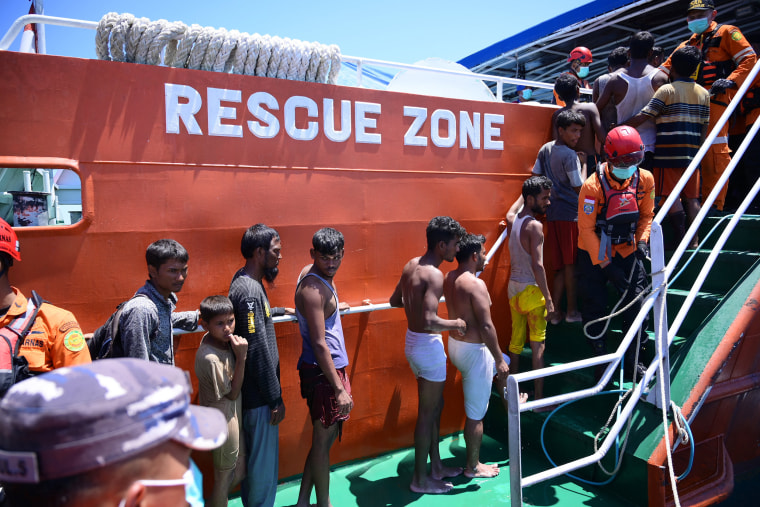
Amiruddin, a tribal fishing community leader in Aceh Barat district, said those rescued indicated that the boat was sailing east when it started leaking.
Then, strong currents pushed it toward the west of Aceh. The six said others were still trying to survive on the capsized craft.
About 740,000 Rohingya were resettled in Bangladesh to escape the brutal counterinsurgency campaign by security forces in their homeland of Myanmar .
Thousands have been trying to flee overcrowded camps in Bangladesh to neighboring countries, with Indonesia seeing a spike in refugee numbers since November, which prompted it to call on the international community for help.
Rohingya arriving in Aceh face some hostility from some fellow Muslims.
Indonesia, like Thailand and Malaysia, is not a signatory to the United Nations’ 1951 Refugee Convention outlining their legal protections, and so is not obligated to accept them. However, they have so far provided temporary shelter to refugees in distress.
Last year, nearly 4,500 Rohingya — two-thirds of them women and children — fled their homeland of Myanmar and the refugee camps in neighboring Bangladesh by boat, the United Nations refugee agency reported.
Of those, 569 died or went missing while crossing the Bay of Bengal and Andaman Sea, the highest death toll since 2014.
Returning safely to Myanmar is virtually impossible because the military that attacked them overthrew Myanmar’s democratically elected government in 2021.
No country has offered them any large-scale resettlement opportunities.
The Associated Press
MORE SECTIONS
- Dear Deidre
- Visual Stories
MORE FROM THE SUN
- Newsletters
- Deliver my newspaper
- Sun Vouchers
- The Sun Digital Newspaper

Grinning small boat pilot caged after crossing Channel with more than 50 migrants in dangerously overcrowded dinghy
- Julia Atherley
- Published : 21:10, 21 Mar 2024
- Updated : 21:10, 21 Mar 2024
- Published : Invalid Date,
AN illegal migrant has been jailed for piloting a dinghy packed with more than 50 people across the Channel.
Choul Phan Maker’s sentence came on the same day more than 500 small boat migrants arrived in Britain — the highest number so far this year.

Maker, 31, was pictured with his hand on the tiller of the inflatable as he steered the overcrowded craft towards our shores last August.
Border Force officials intercepted the boat, with 52 people on board, and Maker was arrested.
At Winchester crown court yesterday, he admitted unlawful arrival and assisting unlawful immigration and was jailed for 20 months.
That day also saw the arrival of 514 illegals in ten boats, with the Government admitting it was facing a “migration emergency”.
READ MORE UK IMMIGRATION

Rwanda scheme faces MORE delays after unelected peers inflict defeats on Govt

Channel crossing horror as migrant 'stabbed' on small boat rammed with 60 people
Maker, from South Sudan , had been booted out of France after being caught trying to smuggle himself to the UK in a lorry.
He spent more than three years in Europe before travelling from Malta for his latest attempt to cross the Channel .
After his arrest, Maker told police that he had been asked to pilot the dinghy by a gang that organised the journey.
Illegal migration minister Michael Tomlinson said: “The criminal gangs behind these crossings don’t care if people live or die, as long as they pay, but they rely on migrants who are willing to steer their deadly crossings through the water.
Most read in News

Anger over 'woke' cross on England shirt as football legends wade in

Shocking footage shows killer’s MUM helping cover up brutal murder of girlfriend

Tina O'Brien given time off after crisis meeting with soap bosses over brawl

Iconic 80s band selling tickets for O2 show for just £10
“Putting lives at risk by taking charge of these dangerous, illegal crossing attempts will not be tolerated and it is right this pilot has been brought to justice.”
The Home Office’s Steve Blackwell added: “This pilot thought nothing of endangering dozens of lives in order to make his own illegal journey to the UK.

“His sentence shows anyone caught piloting these dinghies can expect to be arrested and prosecuted.”
More than 4,000 migrants have crossed the Channel so far this year — with 1,788 arriving in 36 boats this month alone.
Last year, the record for daily arrivals was 401 people who got to Dover in seven small boats on March 4.
The Government’s Rwanda Bill, which will see illegal migrants deported to Africa, has been delayed beyond Easter after another House of Lords defeat this week.
PM Rishi Sunak’s spokesman said today: “The legislation is dealing with a migration emergency and we are introducing that legislation as soon as we possibly can to reduce the number of people taking the perilous journey across the Channel.”
He added that it was “frustrating” the Lords had blocked the bill.
A Home Office spokesman said: “We continue to work closely with French police as they work tirelessly to prevent these dangerous, illegal and unnecessary journeys.”
Yvette Cooper , Labour’s Shadow Home Secretary, said: “More people crossed the Channel in a single day than the Tories plan to send to Rwanda in a year — yet their scheme will cost the taxpayer a staggering half a billion pounds.
READ MORE SUN STORIES

Celebrity Big Brother star Zeze Millz's offensive tweets resurface

Pregnant Daisy May Cooper cradles her bump on walk with DJ boyfriend
“Labour will clear the asylum backlog, end hotel use, and set up a new returns and enforcement unit so those with no right to be in the UK are swiftly returned.
“Labour has a plan to strengthen our border security, relentlessly pursue the smuggling gangs, and restore order to the border once more.”
- Home Office
- The Sun Newspaper
- UK Border Force
- UK immigration crisis
- English Channel

Grinning people smuggler who brought 52 migrants to UK on dangerously overcrowded dinghy is jailed for 20 months
- Choul Phan Maker, 31, from South Sudan smiled while piloting a dangerous boat
A grinning people smuggler has been jailed for 20 months after trying to take more than 50 migrants across the Channel in a 'perilously overcrowded dinghy'.
Choul Phan Maker, 31, from South Sudan, was sentenced at Winchester Crown Court for offences of unlawful arrival and assisting unlawful immigration after making the crossing which 'endangered' the passengers.
He was photographed by Border Force officials grinning with his hand on the tiller as he brazenly steered the boat towards the UK on August 15 last year.
Maker had previously been ordered to leave France after being caught attempting to enter the UK in a lorry.
He spent more than three years in Europe before travelling from Malta for his latest attempt to cross the Channel.
Maker admitted to piloting the boat when he was arrested, telling officers he had been offered the job by a criminal gang who facilitated the journey.
READ MORE: French police stop four migrant boats from heading to the UK a day after British crews came to the rescue of packed vessel after it motored away from French coastguard
He was sentenced to one year and eight months in prison for unlawful arrival and 10 months for assisting unlawful immigration, to be served concurrently.
A Home Office spokeswoman said: 'Choul Phan Maker was caught piloting a vessel packed with 52 endangered passengers, many of whom were forced to stand on makeshift flooring.
'He was photographed by Border Force officials, grinning, with his hand on the tiller, as he brazenly steered the boat towards UK shores on 15 August last year.
'Maker, from South Sudan, had previously been ordered to leave France after being caught attempting to enter the UK in a lorry.
'He then spent more than three years in Europe, before travelling from Malta for his latest attempt to cross the Channel.
'Criminal and Financial Investigation officers identified Maker as the boat's pilot and started gathering evidence to support his conviction.
'He was subsequently arrested and admitted to piloting the boat, telling officers that he had been offered the job by the criminal gang who facilitated the journey.'
Steve Blackwell, deputy director of Criminal and Financial Investigations at the Home Office, said: 'This pilot thought nothing of endangering dozens of lives in order to make his own illegal journey to the UK.
'I'm thankful for the quick work of my investigating officers, which has led to us bringing this criminal to justice. His sentence shows that anyone caught piloting these dinghies can expect to be arrested and prosecuted.'
The Home Office spokeswoman said small boat crossings to the UK have fallen by 36%, while arrivals into Europe from Africa have increased by more than 70%.
According to analysis of Home Office figures, 3,529 people had made the Channel crossing in small boats up to March 19 this year compared with 3,683 by the same point last year.
Illegal migration minister Michael Tomlinson said: 'The criminal gangs behind these crossings don't care if people live or die, as long as they pay, but they rely on migrants who are willing to steer their deadly crossings through the water.
'Putting lives at risk by taking charge of these dangerous, illegal and completely unnecessary crossing attempts will not be tolerated and it is right that this pilot has been brought to justice today.'


IMAGES
COMMENTS
Lengthen the painter so that the dinghy is towed further away, allowing it to recover from each wave and fall back before striking the boat. Pull an inflatable dinghy in very close to the stern and rig a line from each towing eye out to the stern quarters of the sailboat. When these lines are pulled tight, the dinghy snubs against the stern and ...
Your towing bridle, hardware, and line are key. For very short distances with a hard-bottomed dinghy that tracks well and has a padeye on the stem (at least 6 inches below the gunwale so the bow rides high), you may be able to get away with attaching a single line directly between the tow and the big boat.
They will need to balance the dinghy to keep it level and steer to follow the towing boat. The dinghy crew can drink tea on the yacht, leaving the helm to steer to follow the yacht's transom. If the dinghy is being towed with no crew on board, the centre-board should be secured fully up and the helm tied amidships with the rudder down.
Captain John with 25+ years of experience shows you the no-nonsense cruising skills you need for safer sailing worldwide. Visit his website at https://www.sk...
This video explains how to safely tow a dingy.
Add life to your expensive sailing dinghy or inflatable when you need to tow it astern of your sailboat. Lessen the stress on your dinghy towing eye and boat...
I have towed a 9.2 foot inflatable dinghy without problem. To spread the towing load, I tie a bridle to the two towing rings on either side of the bow. From the middle of the bridle, I tie one towline about 30 to 40 feet long when sailing in open water. I shorten this to about 10 feet when towing in narrow channels.
At slow speeds, the outboard will have much more steering effect than the boat's rudder. Diagram 3 Backing into a slip using a side-tow arrangement requires good communication between the boat's helmsman and the dinghy operator. If no one is at the boat's helm, be sure that it's securely lashed amidships. Tim Barker
Attach the ends of your line through the D-rings and make a triangle with the rope that extends a few feet beyond the bow in the direction of your boat. Move the bridle (the triangle) through a bowline close to the end of the tow line. This allows for some slippage in the line so the bridle can move as the dinghy's weight inevitably shifts as ...
The three most common places to carry the dinghy are: Towed behind the boat, On the stern in davits, and on the deck. Each of these locations has its pros and cons, and where you decide to carry it is up to you! Towing your dinghy may seem like the easiest of methods. It simply follows you along like a puppy, going everywhere you go.
In calm water, about two waves back. If it gets rough, adjust the length of the towline so that when the boat crests a wave, so does the dinghy. Remember: Syncing the boat and tow helps avoid sinking the boat you tow. Bring the dinghy in close for docking, but don't chop the throttles, lest your dinghy slams into your transom.
Towing the dingy will slow the boat, how much depends on the dinghy, the size of the boat towing, and wind speed. When motoring it is not noticeable. Once the wind is strong enough to drive the boat at or near hull speed the dingy has no effect. In lighter air the dingy will slow the boat down.
Dinghy sailboats can be stored in a variety of places depending on the availability of space and the individual's preferences. ... It is important to ensure that the trailer is properly balanced and the trailer tires are properly inflated before towing the dinghy. Additionally, any straps or chains used to secure the dinghy to the trailer ...
Beyond that , the diameter of the tubes is very, very, important. Generally speaking, dinghy tubes range between 16in and 19in, with a larger tube diameter providing an appreciable dryer ride. A 10.5ftinflatable with 16in tubes, for example, is a much wetter ride than a 9.5ft dinghy with 19in tubes. That said, for seasonal sailors with only ...
A: Towing a dinghy successfully requires thought and planning. There are several things to consider, some of which aren't immediately apparent. First, ask yourself if you really want or need to tow your dinghy and why. Remember, towing anything behind a boat will slow you down and require more energy in the form of fuel or wind power.
Painters are generally not long enough to serve as towlines. Towlines should be long enough so the dinghy rides about 2 waves behind the boat. That distance will differ with sea conditions and your cruising speed, but a 30-50 ft towline is a good approximation. A typical dinghy tow line might be 40 feet of 7/16" diameter line.
Dinghy Storage on a Sailboat. Tenders are an essential part of the cruising life, but can be cumbersome to carry. Here are five basic options. By Dan Spurr. Updated: August 28, 2020. As proved in the 2020 Boat of the Year competition, drop-down transoms and dinghy garages are now "a thing.". The Bavaria C57 includes space for life-raft stowage.
Welcome to Dinghy-Tow.com. For many years sailors have struggled with the problems associated with inflatable dinghies - uncontrollable towing situations, the difficulty in storing dinghies and the hazards of motor removal that davits just don't solve. With the Dinghy-Tow system installed on your sailboat, these problems are a thing of the past.
A tow bridle is required to properly tow your inflatable. In this article, we will share the correct method for towing your rubber dinghy. When towing a Newport Vessels dinghy boat, we recommend a 3-point bridle for the most effective and efficient means of towing. Some inflatable brands cut costs by limiting hardware, if your dinghy only has ...
Dinghy-Tow lifts the stern of the dinghy out of the water using two stainless steel poles and lifting tackle. Towing in this manner leaves only a small part of the bow in the water resulting in low drag, low windage and an unobstructed view. Dinghy-Tow can easily be adjusted to the heeling action of a sailboat in varying sea conditions.
Ready For Arrival. Just before you arrive at the harbor, marina, or anchorage, pull the dinghy in close before conducting any backing or docking maneuvers. First, bring the mothership to a slow stop, lessening the strain on the line and protecting your hands. Then hand-over-hand the tow line into the boat.
Bring the dinghy upwind when returning to your boat for a more controlled approach. Always use both front and rear-facing lights when operating the dinghy after dark. When towing the dinghy behind your boat, experiment with the length of the tow rope to find the smoothest pull. If there is any surf present, do not attempt to beach your dinghy.
It's impossible to tow a skier, and the sail gets in the way of angling. The inflatable models are okay for fishing in shallow waters or inland water bodies, but the seating setup isn't comfortable. ... Top Dinghy Boat Brands and Models Intex Excursion 5. The Intex Excursion 5 is a great example of an inflatable dinghy. You can seat up to ...
Embark on a captivating journey through maritime history as we explore the origins of dinghy cruising in Episode 2 of NanoCruising. From the humble beginnings of the word "dinghy" to the earliest forms of small boats crafted by ancient civilizations, and the evolution of sailing techniques that have shaped the art of navigation, this episode is a treasure trove of nautical knowledge.
The dinghy was one of eight small boats to reach UK waters on one of the busiest days of Channel ... A total of 1,213 asylum seekers have crossed the Channel in 25 boats so far this month ...
A ship belonging to the charity, SOS Mediterranee, spotted the deflating rubber dinghy on Wednesday, in international waters under the Libyan rescue jurisdiction. Twenty-five dehydrated and ...
Men, women and children, weak and soaked from the night's rain, wept as the rescue operation got underway and people were taken aboard a rubber dinghy to the rescue boat. IE 11 is not supported.
AN illegal migrant has been jailed for piloting a dinghy packed with more than 50 people across the Channel. Choul Phan Maker's sentence came on the same day more than 500 small boat migrants ...
A grinning people smuggler has been jailed for 20 months after trying to take more than 50 migrants across the Channel in a 'perilously overcrowded dinghy'. Choul Phan Maker, 31, from South Sudan ...